| | |
Template:Cleanup-confusing Warning: This infobox has missing parameters: sector, system and unrecognized parameters: defacto
- "Imperius Unitada ober Totallex"
- ―Atrisian Basic motto and name of a propaganda piece, literally translating to "Empire united over all"
The Galactic Empire (19 BBY–5 ABY), also known as the First Galactic Empire, the New Order, or simply the Empire, was the fascist government that replaced the Galactic Republic in the aftermath of the Clone Wars.
Secretly ruled by Dark Lord of the Sith Darth Sidious—publicly known as Galactic Emperor Palpatine—the new regime rose to power with a groundswell of populist support, promising peace and stability from the destructive Clone Wars and capitalizing on anti-Jedi and anti-droid sentiment. The subsequent Age of the Empire would last only two decades in contrast to the centuries of the Republic Era, but not before the Jedi Order was systematically purged and almost eradicated, and the galaxy largely conquered.
The Empire stood virtually unchallenged until numerous insurgent cells united to form the Alliance to Restore the Republic in 2 BBY. The Galactic Civil War ensued with the theft of the Death Star plans on Scarif which, in turn, led to the destruction of the Empire's superweapon at the Battle of Yavin in 0 BBY. The following years saw initial Alliance successes until a major Imperial victory on Hoth in 3 ABY, only to suffer a devastating defeat a year later at the Battle of Endor. During the battle, Emperor Palpatine was slain at the hands of his apprentice Darth Vader, who also died shortly after turning against his master.
With the Sith extinct, the Empire fractured into several remnant factions that were dominated by Moffs, admirals and generals, many of whom ignored Grand Vizier Mas Amedda's authority as the de jure Imperial successor. In this fractured state, Imperial holdouts were referred to as Imperial remnants. The largest remnant was publicly led by Grand Admiral Rae Sloane and covertly ruled by Fleet Admiral Gallius Rax and his Shadow Council. Ultimately, Rax seized control over the largest faction of the Imperial Navy after removing Sloane from power; and therefore, became Emperor-in-effect through his new position as Counselor to the Empire. Under Rax's rule, the Empire made its final stand at the Battle of Jakku in 5 ABY, ultimately losing to the New Republic. While several remnants continued to resist, the Empire formally capitulated to the New Republic with the signing of the Galactic Concordance.
During the era of the New Republic, war reparations and disarmament treaties reduced the Empire to a rump state ruled by hardliners. What remained of the old establishment was forced to remain within the borders of the Core and Inner Rim and agree to punitive stipulations. The central government on Coruscant was reorganized into a provincial administration overseen by New Republic observers. In the decades that followed the Imperial government's dissolution, it was remembered as the Old Empire.
Following the Empire's defeat, surviving loyalists, technocrats, and military leaders fled to the galaxy's Unknown Regions to form the First Order, a military junta based on the ideals of the Old Empire as per the Emperor's posthumous contingency plan. In time the First Order evolved into a military junta led by Supreme Leader Snoke who like Sidious, was a master of the dark side of the Force—although he was not a Sith Lord. In 34 ABY, the First Order attacked the New Republic, ending the decades-long cold war. Even without Starkiller Base, which had been subsequently destroyed in battle by the Resistance, the First Order stood poised to conquer the galaxy in the wake of the New Republic's collapse. By then, Snoke had been assassinated by Kylo Ren, the grandson of Darth Vader, who envisioned himself at the head of a new galactic order—one that would surpass the Empire, the Republic, and all that came before.
History
Early foundations
- "I have good news for you, my Lord. The war has begun."
"Excellent. Everything is going as planned." - ―Dooku and Darth Sidious
For at least a thousand years,[20] the dominant governing body of the galaxy was the unicameral and democratic Galactic Republic, led by an elected Supreme Chancellor.[20][21]
In the last decades of its existence, the Republic Senate became mired in bureaucracy, rendering it woefully ineffectual as a governing body. Darth Sidious, the Dark Lord of the Sith known publicly as Senator Sheev Palpatine of Naboo, privately lamented the declining state of the Senate, noting that the Republic was "not what it once was."[21][22]
Thirteen years before the Republic's end as a democracy, Darth Sidious orchestrated the invasion of Naboo by the Trade Federation, in order to create a leadership crisis in the Senate. Sidious used the crisis to manipulate the then Queen of the Naboo, Amidala, into calling a Vote of No Confidence against sitting Supreme Chancellor Finis Valorum. The vote passed, and in the subsequent election, Sidious—in his public persona of Palpatine—secured the position of Supreme Chancellor of the Galactic Republic for himself.[21] Ultimately, he would be the last individual to hold this office.[3]
In the decade that followed, Sidious secretly manipulated galactic events to the extent that war became inevitable. Besides persuading a dead Jedi Master, Sifo-Dyas, to create a secret clone army, he also tasked his Sith apprentice, Darth Tyranus, with exacerbating political tensions in the Republic and engineering a Separatist Crisis. These actions would culminate in the outbreak of the Clone Wars, the last conflict of the Republic, while Sidious himself "reluctantly" accepted emergency powers.[20][3]
Birth of the New Order
- "In order to ensure our security and continued stability, the Republic will be reorganized into the First Galactic Empire! For a safe and secure society."
- ―Darth Sidious, on the birth of the New Order
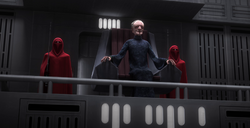
Palpatine's leadership became more authoritarian during his wartime chancellery.
Since the onset of the Clone Wars in 22 BBY, the Republic endeavored to strengthen its security and stability through the creation of new organizations such as the Commission for the Protection of the Republic (COMPOR), which utilized propaganda to increase public morale, promote patriotism, and foster anti-Separatist sentiment within the general population.[7] As the Republic became increasingly centralized, however, Chancellor Palpatine's powers continued to grow through additional assets ceded to the Office of the Chancellor, including the galactic banking system that was placed under his direct oversight.[23]
The Chancellor remained a popular leader for the duration of the war, having managed to stay in office at the will of the Senate for longer than his term permitted. As he consolidated and centralized his own power, his influence expanded to an unprecedented level while the Republic shifted from a democratic government to an increasingly militarized and authoritarian regime on the grounds of security and stability. In addition to his authority as Commander-in-Chief of the Republic Military, the Chancellor exerted more control over the Senate, the courts,[3] and even the media with HoloNet News becoming a state-run program in order to ensure that information would not be compromised by the Confederacy of Independent Systems.[24] Sidious' hold over the Republic further expanded with additional amendments to the Galactic Constitution[3] while public support for the Jedi weakened as the war carried on,[25] paving the way for his ultimate ascension as Emperor of the galaxy.[3]
As the war neared its end in 19 BBY, the Jedi Order had grown skeptical about the Chancellor after his accumulation of emergency power. They began to suspect that a plot to destroy the Jedi was close to fruition. The ruling council started discussing forcibly removing Palpatine from office and temporarily overseeing the Senate in order to maintain political stability during the transition period. However, the Jedi learned of Palpatine's true identity as Dark Lord of the Sith, Darth Sidious. Following an attempt to arrest him, a brief but vicious fight ensued in which Sidious killed several Jedi and was himself visibly injured. The intercession of Jedi Knight Anakin Skywalker, who was a personal friend of Chancellor Palpatine and already disillusioned with both the Order and the war, ensured Sidious' victory. The prodigal Jedi was turned to the dark side of the Force, while Sidious had a pretext upon which to turn the Republic against the Jedi.[3]
Darth Sidious immediately purged the Jedi Order, issuing to the clone army Order 66: to exterminate all Jedi. With this command programmed into the clones since their births on Kamino,[26] the Republican soldiers (except for Captain Rex, Commander Wolffe and Captain Gregor, who all had their protocol 66 programming chips removed during the war, and also clone Medic Kix, who was missing) immediately turned on their Jedi commanders and exterminated the vast majority of the Jedi Order in an instant. Meanwhile, Skywalker—rechristened as Sidious's new apprentice Darth Vader—attacked the Jedi Temple and wiped out what remained of the Order. However, certain Jedi survived the purge, such as Grand Master of the Jedi Yoda,[9] Skywalker's former Jedi Master Obi-Wan Kenobi,[1] Masters Selrahc Eluos,[27] Kirak Infil'a,[28] Coleman Kcaj, Ka-Moon Kholi, Oppo Rancisis, Quinlan Vos, Luminara Unduli and Uvell, former Master Eeth Koth, Chief Librarian Jocasta Nu, Knights Zubain Ankonori, Khandra, Mususiel and Nuhj, Skywalker's former Padawan Ahsoka Tano, as well as Padawans Ferren Barr, Caleb Dume and Cal Kestis. Many of them went into hiding after Yoda and Kenobi fought their way into the Temple and transmitted a holographic message warning the other Jedi about the Republic trap waiting for them there, right before the two Masters failed to destroy the Sith and headed into exile themselves. Some of them, however, were initially found and either turned to the dark side—as members of an agency of dark side adepts which later became known as the Inquisitorius before being tasked by Sidious with hunting down and destroying the remaining Jedi—or taken prisoner, as Unduli was within the Spire on Stygeon Prime until her execution, after which her remains were preserved by the Inquisitorius to lure other Jedi to their fate.
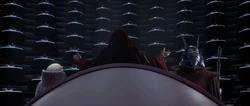
With the end of the Clone Wars, Darth Sidious became Emperor of the First Galactic Empire.
Shortly afterwards, Palpatine turned his eyes to the Confederacy of Independent Systems and dispatched Darth Vader to wipe out Nute Gunray and the rest of the Separatist government leaders on Mustafar, following which Imperial financier Arsin Crassus plundered the Trade Federation's accounts to fund the new Imperial government.[3][12] Now able to demonstrate threats to the Republic from both within and without, a visibly injured and scarred Sidious addressed the Galactic Senate to announce the reforms which had been his plan since the beginning. To the thunderous applause of the Senators, Sidious—known publicly as Palpatine—announced that in order to preserve security and continued stability, the Republic would be reorganized into[3] the First Galactic Empire[29] and self-proclaimed himself as Galactic Emperor.[3]
Imperialization
- "Emperor unveils ambitious plan for Imperial fleet expansion"
"Count Vidian contributes star power to new industrial inspection tour"
"Leftover unexploded ordnance from Clone Wars remains a concern" - ―Headlines, Imperial HoloNews (Gorse Edition)
A celebration of the demise of the Jedi led by Grand Vizier Mas Amedda
Existing government bodies were renamed to reflect the change in authority as civil and military superstructure of the Old Republic were overhauled immediately under the personal direction of the Emperor. With vast portions of the galaxy still unconquered, the Grand Army of the Republic became the Imperial Army,[30][7] while the Republic Navy became the Imperial Navy and the Galactic Senate was rechristened the Imperial Senate.[1] The renowned Senate Plaza, with its name reminding residents of the Old Republic, was promptly changed to the Imperial Plaza, while an enormous statue of the Emperor was erected there.[7] In addition, the former roundel of the Republic was replaced with the new Imperial crest, adorned on almost everything having to do with Palpatine's Empire.[31] For the next decade and a half, Imperial rule—bolstered by the military created to fight in the Clone Wars—dominated the galaxy and was largely unchallenged. The Empire soon began to upgrade its military hardware, replacing V-wing and ARC-170 fighters with newer TIE models five years after the Clone Wars, but Republic-era military equipment continued to be used for a while on distant outposts and locations such as Galidraan Station.[7] The Republic's Phase II clone trooper armor would begin a phase out and be replaced by superior stormtrooper armor, whose development had been headed by the Imperial Department of Military Research.[31]
After the Separatist Droid Army was promptly shut down, its navy was dismantled at locations across the galaxy such as the Bilbringi shipyards. However, various droid models and Separatist technology escaped Imperial appropriation and managed to work their way onto the black market, with many modules taken from Separatist frigates and destroyers, including pieces from Admiral Trench's warship, the Invincible. Despite Separatist-era technology continuing to be used and appearing in locations such as the Corporate Sector, the Empire continued to root out remaining holdouts of the Confederacy four years after the Clone Wars, while criminal organizations composed of repurposed battle droids such as the Droid Gotra operated in Coruscant's underground.[7]
Any Jedi survivors of Sidious' purge were systematically hunted down and killed either by Darth Vader[1] or any of the Emperor's additional agents among the Inquisitorius in the years that followed the rise of the new order. When Zubain Ankonori and his nest of fellow Jedi (such as Khandra, Mususiel and Nuhj), for example, were all found by the Empire in hiding within the Jedi shrine on Anoat, they were forced to separate and flee, only to be tracked and killed by an Inquisitor one by one.[32] Within two decades, only a few known Jedi were still alive and in exile to avoid the Empire's wrath: Yoda went into hiding on Dagobah to continue his studies of the Force and watch from afar as other Jedi operated throughout the galaxy; Kenobi went into hiding in the Jundland Wastes on Tatooine as a strange hermit called "Old Ben" to give Vader's newborn son Luke Skywalker to the father's stepbrother Owen Lars and watch over the boy as he grew up on the Lars homestead; Uvell went into hiding in an abandoned Geonosian colony on a remote moon after giving antiques dealer Antron Bach numerous Jedi scrolls, lightsabers and other objects of historical significance to hide;[33] Ahsoka Tano went into hiding in the Outer Rim world of Thabeska, and later relocated to the farming moon Raada as a mechanic named "Ashla" to make a life for herself in the farming community;[34] Caleb Dume changed his name to Kanan Jarrus before going into hiding in Gorse City on the tidally locked Inner Rim planet Gorse as a bartender for The Asteroid Belt bar and freighter pilot carrying baradium bisulfate for Moonglow Polychemical between Gorse and its moon, Cynda.[35] In order to draw out any of these Jedi and the children capable of touching the Force whom they might take as their Padawans, the Empire charged the Inquisitorius with not only tracking the Order 66 survivors down, but also preventing the Force-sensitive youth of the galaxy from being used against the Empire.[36][37]
As pirates, smugglers, and ex-Separatists were routinely imprisoned and destroyed, the Empire faced little serious resistance to its rule. A rare exception revolved around the Outer Rim world of Ryloth, where Moff Delian Mors and Colonel Belkor Dray were fighting an insurgency known as the Free Ryloth movement, led by former Twi'lek Resistance leader Cham Syndulla, who established hidden bases across Ryloth and executed raids against the Empire, including those on its lucrative spice and slave trade in the sector. Composed of freedom fighters who fought with the Galactic Republic and Jedi Master Mace Windu during the Clone Wars to free their homeworld from Separatist occupation by Emir Wat Tambor, the newly formed Free Ryloth movement would continue its struggle for independence against the Galactic Empire for decades. Seeking to make examples of worlds who continued to harbor secessionist tendencies, Moff Wilhuff Tarkin was assigned to make an example of Antar 4, a populous moon that had been a part of the Separatist Alliance and involved in a scheme involving Republic Intelligence to train locals into well-armed resistance groups. While COMPNOR initially stifled information regarding the killings, word soon leaked about the operation through inquisitive reporters such as Anora Fair and Hask Taff, while the event was soon penned as the Antar Atrocity, capturing the attention of many Coruscanti and other citizens from the Core Worlds.[7][38]
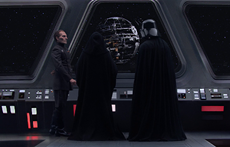
Vader, Sidious, and Tarkin oversee the Death Star's construction.
In total secrecy, the Empire took over construction of a massive battle station with enough firepower to destroy an entire planet, later known simply as the Death Star, that had formerly been a Separatist project engineered by Geonosian archduke Poggle the Lesser's hive colony for Darth Tyranus, who was entrusted with the project's plans for safekeeping throughout the Clone Wars, with supplies coming from various planets and locations such as Sentinel Base and Geonosis.[20][1] The Emperor's long-term plan was to allow what he called the "skeleton of the Republic" to remain in place until the Death Star was completed; this included maintaining the Senate to make the systems believe that they still had a part to play in the government. However, upon the superweapon's completion, the Emperor planned to dissolve the Senate and grant its legislative and administrative powers to the military-industrial complex. The Death Star would also provide order to the galaxy, as part of Grand Moff Wilhuff Tarkin's doctrine of terror, by making its inhabitants too afraid to defy an Imperial command and stand against the Empire.
However in 16 BBY, various survivors of the Antar Atrocity and other malcontents joined together under the leadership of the former Captain Berch Teller, who organized them into a rebel cell intent on stalling the development of the Emperor's newest weapon under construction at Geonosis. After stealing the Carrion Spike, an advanced starship based on a prototype stealth corvette used during the Battle of Christophsis during the Clone Wars, the rebels wreaked havoc across numerous star systems including Lucazec, Galidraan III and Nouane, all while transmitting holovids of their attacks on Imperial HoloNet frequencies, increasing anti-Imperial propaganda across thousands of Mid and Outer Rim star systems before the Empire was able to shut down the communications grid. After lengthy fleet redeployments and the discovery of a mole within the Imperial ranks, Tarkin, aboard the Imperial-class Star Destroyer Executrix, managed to disable the rebel warship and capture the dissidents after a brief battle and timely arrival of Star Destroyers Compliant and Enforcer. To reward Tarkin's skill, the Emperor promoted him to the newly created rank of Grand Moff and gave him command of the Executrix as well as oversight of the Outer Rim Territories, all while the recent attacks on Imperial facilities were made to look like an elaborate plot to root out rebel cells. The Empire had effectively dealt with a potentially disastrous situation, rooted out a traitor and kept details regarding the development of its superweapon at Geonosis a mere rumor.[7][39]
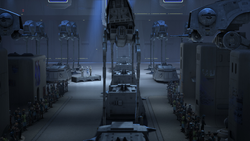
"Glory of the Empire" was played during the yearly Empire Day celebrations across Imperial space.
As the Galactic Empire grew, Palpatine moved closer to his ultimate plan of ruling the entire galaxy and unlocking the secrets of the Sith Masters who had come before him. With the near extermination of the Jedi Order and the Empire swelling in size and strength, the Emperor ultimately planned to possess the powers of the dark side to reshape reality itself into something of his own creation, and an omnipotent Empire would allow all the galaxy's inhabitants to be held in his dark embrace.[18][7] As most planets were ecologically devastated, rampant industrialization and mass-production eroded local culture and ecological health. Men and women saw their sons and daughters drafted into Imperial service, while corrupt governors and magistrates often exploited local populations on worlds such as Jelucan, Devaron and Tangenine. Parades, obligatory attendance at patriotic functions and the erection of barracks and garrisons on various worlds across the galaxy became the norm. While the Empire turned a blind eye to various abuses, it still maintained a policy of zero corruption and maintained its high standards of conduct, resulting in numerous Imperial Security Bureau (ISB) officials actively hunting down corrupt and negligent officials, even resulting in investigations by Lord Vader himself. Despite this, many citizens were content with the geopolitical situation in the galaxy, believing that strict measures were necessary to maintain order and stability after the destructive Clone Wars. Many also believed that the Empire, while not the best, was better than anarchy and chaos.[18][29][7] While many tolerated and even supported the Empire, many others continued to hold separatist tendencies and even exuded hostility, with those who fought in the Clone Wars seeing the transformation of the Empire from a source for order into a brutal bully in a quest for control. During this so-called Age of the Empire, worlds such as Naboo underwent rampant beautification projects in an effort to produce idealized versions of life in the Empire as a whole, with the state-sponsored HoloNet continually citing new building projects, successful trade negotiations, and endless economic prosperity. Many supported the growing view of the Empire as a nearly invincible force.
Despite its seemingly endless expansion, such as on Raada, where Imperial forces arrived to harvest food which destroyed the quality of the moon's soil and presence led to a growing oppression that angered the people of Raada (to the point where they staged an uprising after weeks of planning, with the help of Ahsoka Tano, and the forces of Imperial Senator Bail Organa in secret), a major turning point against the Empire's advance into the Outer Rim occurred eight years after the end of the Clone Wars and eleven years before the Battle of Yavin, with Imperial forces commanded by Captain Rae Sloane engaging in a small skirmish in the vital Inner Rim system of Gorse. This event saw the meeting of later rebels Hera Syndulla and Jedi survivor Kanan Jarrus, who were confronting efficiency expert Count Denetrius Vidian and his aggressive methods of extracting thorilide—a vital component in the construction of turbolaser batteries and thus essential for the expansion of the Imperial fleet. The Gorse conflict ultimately ended with the transferring of local thorilide mining operations to Imperial-aligned Baron Lero Danthe, while Hera Syndulla and Kanan Jarrus departed on the heavily modified VCX-100 light freighter Ghost, and would become essential to the eventual formation of the Rebel Alliance.[35][40] Meanwhile, more and more worlds within the Empire began to realize its true intentions: After various massacres on Kashyyyk and increasingly brutal tactics, such as the Empire committing genocide on the Lasat homeworld of Lasan, a growing number of citizens of the galaxy began to rebel against Imperial dominion. At least nine years after the proclamation of the New Order, the Corellian Resistance fought the Empire from its headquarters on the planet Corellia.[33]
The Empire would also end the independence of many galactic, sector and planetary governments in its early conquests, such as the Noble Court, who had lost the Anoat sector that they had ruled over for many years, and resulted in the Empire replacing them with a governorship led by Ubrik Adelhard while issuing a number of kill orders on the nobles. The Empire then claimed to have wiped out the Anoat nobility. However, many members of the Court survived and went into hiding as a government in exile while working to restore the kingdom.[32] The Empire, meanwhile, did not restore independence to the Mandalore system following the Clone Wars; instead, Lady Bo-Katan Kryze and the Mandalorian houses and clans lost power to Imperial-backed Clan Saxon,[41] with Gar Saxon ruling as its Viceroy.[42] As proxies of the Empire, Saxon and his Imperial Super Commandos enforced the Emperor's will on Mandalore.[43] However, the Galactic Empire forged a partnership with the Chiss Ascendancy, on behalf of the Aristocra; Mitth'raw'nuruodo, or Thrawn, became the Chiss ambassador to the Empire, with the Emperor accepting Thrawn's offer to serve as his advisor on matters relating to the Unknown Regions. Thrawn sent Eli Vanto to the Ascendancy as an emissary, where he met Admiral Ar'alani of the Chiss Defense Fleet and told her that he was sent because he believed that he could be a great help to the Chiss as Mitth'raw'nuruodo would be to the Imperials.[44]
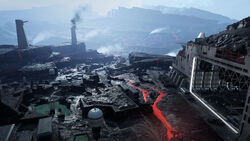
Sullust was an example of the Empire's industrial development.
Around fourteen years into Palpatine's rule as Emperor, the Empire had begun its expansion into the Outer Rim. Worlds like Jelucan saw occupation and development, leading to rampant pollution and industrialization to support the Imperial war machine.[18] One such world that was developed was Lothal, which joined the Imperial Registration Program seeking protection and economic opportunities whereby local citizens would find work in the local Sienar Fleet Systems facilities.[45] Ostensibly this was to grow the local economy, but was in fact secretly part of a much larger five-year plan involving numerous Outer Rim worlds that was overseen by the Imperial Outer Rim High Command, a subdivision of Imperial High Command which was in charge of the Outer Rim Territories.[14] But the Empire did not fully control the Outer Rim and often utilized its worlds instead as testing grounds for new biological weapons and as a source of cheap labor.[12] Lothal's industrial importance soon came to the fore for the Empire as the Emperor planned to further expand Imperial dominion over the Outer Rim Territories and beyond. In order to maximize the worth of newly occupied systems, worlds such as Lothal soon bore witness to Imperial authorities relocating farmers away from their farmlands to mine for Imperial purposes, leading to the development of re-settlement camps such as Tangletown[30] and Lothal re-settlement camp 43, known by the residents as "Tarkintown" after the Governor of the Outer Rim.[34] The Empire also limited the HoloNet across the Outer Rim, leading many dissatisfied systems to view the embargo as a part of the conquest of the Outer Systems.[7]
This aggressive dislocation of persons and high tax rate eventually led to the development of a small and localized, albeit serious upheaval in 5 BBY against Imperial authority on Lothal. Although the other separate insurgencies across the Imperial territories was of little consequence, the Emperor did foresee a new threat rising against the Empire—the children of the Force. But the Empire overall did not fear that the various rebel cells could unite and form a more potent menace against the Empire and its interests in the Outer Rim. Imperial Military command maintained a list of known Rebel sympathizers on several Outer Rim worlds, including Lothal, but most of them were not arrested due to their having powerful allies in the Senate, a known hotbed of corruption and decadence.[46] Among these cells on Lothal was the Rebel crew of a VCX-100 light freighter called the Ghost, consisting of Jedi Purge survivor Kanan Jarrus, the Twi'lek pilot Hera Syndulla, the Lasat genocide survivor Garazeb Orrelios, a sixteen-year-old Mandalorian Imperial Academy dropout Sabine Wren and the now fifteen-year-old Ezra Bridger. When rumor of the discovery of Jarrus' Jedi identity and his duty on leading the insurgency began to emerge, the Empire sent the leader of its Inquisitorius, the Grand Inquisitor, to track him down.[47][48]
Eventually, in 4 BBY, in a daring battle over Mustafar, the Ghost crew joined with a growing rebellion. The rebels, commanded by former Padawan Ahsoka Tano, were part of a larger rebel movement across the entire galaxy which included several cells, led by Tano and Imperial Senator Bail Organa, and purposely kept in darkness about the existence of one another to prevent information leaks and Imperial crackdowns. Following rumors of an Imperial defeat over Mustafar, spontaneous riots and unrest on several Imperial worlds occurred. The size of the rebellion had also caused concern in the higher ranks of the Empire. With the Grand Inquisitor's death, the Emperor sent his loyal enforcer, Darth Vader, to quash the threat to the Empire's reign.[49]
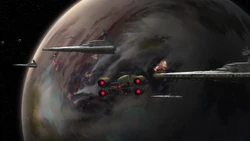
The result of the mass industrialization of the Outer Rim seen on Lothal, with all traces of natural resources being stripped and fires scattered throughout with extreme pollution covering the planet
Following the events on Mustafar, Lord Vader imposed a complete lockdown and blockade of the planet as a disillusioned Minister Tua contacted the Spectres to defect to the rebellion, with Agent Kallus using this to lure the rebels back to Lothal and to capture them, but Tua was killed during the escape attempt. This prompted Kallus to frame the rebels for her murder and send Imperial forces to search for them. The rebels evaded arrest by hiding in the Imperial Complex only to be met by Darth Vader and a duel; however, the rebels managed to escape in a stolen shuttle. Vader then ordered Kallus to raze Lothal re-settlement camp 43, known as Tarkintown, to punish the locals for accepting help from the rebels. After breaking the Imperial blockade, Vader attacked the Phoenix Cell fleet that had been sent from the Organa-Tano alliance of rebel cells, who had come to the aid of the Spectres and inflicted high casualties on it, forcing both rebel cells to retreat into hyperspace. With this, the Empire's operations had been a success and while remaining a threat to the Empire even after pushing the rebels off-world, order had nevertheless been restored on the vital world of Lothal and caused a major setback to the rebellion.[46]
Securing the Outer Rim
- "I will start my operations here, and pull the rebels apart piece by piece. They will be the architects of their own destruction."
- ―Grand Admiral Thrawn
Thrawn was a leading officer during the growing rebellion.
In the aftermath of the victory on Lothal, Admiral Konstantine and the Imperial Navy continued to securing the Outer Rim and also hunting for these rebels. He was accompanied by the Imperial Security Bureau Agent Kallus, who also had experience dealing with these rebels during the revolt on Lothal who had traveled to the desert planet of Seelos to make contact with several retired Clone troopers: Rex, Wolffe, and Gregor and hoped to win them over to their cause but Wolffe who distrusted the rebels sent a coded transmission that was picked up by the Relentless. Agent Kallus led a ground assault with three AT-AT walkers, Konstantine remained aboard the Relentless to render air support to Kallus' forces. However, the clones and rebels joined forces and put up a fierce fight and succeeded in immobilizing Kallus AT-AT walkers. The admiral, however, had been unable to render air support because Lord Vader had ordered him to rendezvous with his shuttle in space,[50] but instead of meeting Vader, Konstantine received another Inquisitor known as the Fifth Brother. When Konstantine raised his concerns that the diversion might have compromised Agent Kallus' mission, the Inquisitor merely replied that his struggles were of no concern to him and pledged to stop the rebels himself.[51] The rebels later helped deliver relief supplies to the famine-stricken planet Ibaar, which was being blockaded by an Imperial fleet. The Empire had doubled the Ibaarians' work quotas and reduced their rations, creating a famine. The first attempt failed and ended with the destruction of the CR90 corvette transporting the supplies. Still, the rebel network persisted, and the rebels succeeded in breaking through the blockade with the help of a Blade Wing prototype starfighter, which destroyed one of the Arquitens-class command cruisers. This enabled the rebels to deliver supplies to the Ibaarian resistance, which subsequently distributed the supplies.[52] While searching for a missing patrol in the Del Zennis system, Commander Sato, Ezra, and several other rebels were captured by an Imperial Interdictor, a prototype warship equipped with gravity well projectors capable of dragging ships out of hyperspace. In response, Kanan, along with Rex and Chopper, staged a rescue mission which ended with the destruction of the Interdictor, dealing a serious blow to Imperial forces.[53]
Lacking a permanent base, one rebel group—the Phoenix Squadron—hid in several spaceports scattered across the planet Garel, but the Empire learned of the rebel presence there and sent a fleet to crush them with most retreating.[54] Following the losses on Garel, Imperial Senator Organa sent his adopted daughter Princess Leia Organa of Alderaan to deliver three Sphyrna-class corvettes to the Rebellion. Since the Alderaanians could not be seen directly supporting the Phoenix rebels, Bail arranged for Leia to deliver the vessels to Lothal, where in secret the rebels would "steal" the ships. However, the local Imperial commander Yogar Lyste had fitted the Hammerhead corvettes with gravity locks, but this failed when the rebels managed to steal the vessel during a skirmish with Imperial forces.[55] With the Empire hunting down the rebels throughout the Outer Rim Territories, the rebels decided to create a new route through the Lothal sector. Sabine identified the Concord Dawn system as a viable route that the rebels could use. The system was home to the Mandalorian Protectors, a Mandalorian faction that was led by Fenn Rau, a veteran of the Clone Wars. Commander Sato sent Phoenix Leader Hera and Sabine on a mission to negotiate safe passage through the Concord Dawn system with Rau. However, Rau had already aligned the Protectors with the Empire and attacked Hera's mission, seriously wounding Hera and killing at least one Phoenix Squadron pilot. In retaliation, Sabine and Kanan infiltrated the Protectors' camp on the third moon of Concord Dawn and destroyed their Fang fighters. The rebels also managed to capture Rau, who agreed to give the rebels safe passage through the Concord Dawn system in return for keeping his capture a secret from the Empire.[56]
Imperial Inquisitors fighting the Jedi and Maul
Eventually, an Inquisitor called the Eighth Brother was sent to seek a shadow on Malachor, within the depths of the Sith Temple on the planet's surface. At the same time Kanan, Ezra and Ahsoka from the rebellion arrived and immediately recognized him as the Nightbrother and former Sith Lord Maul, to who also the Inquisitors confirmed was alive and after the death of the three Inquisitors, Maul turned on his Jedi allies and blinded Kanan. The rebels' problems were further complicated by the arrival of Darth Vader, who had come to take the secrets of the temple for himself. The Jedi managed to remove the holocron from the temple's obelisk, which triggered an implosion that damaged much of the temple. While the two Jedi managed to escape on the Phantom with Chopper, Ahsoka stayed behind to hold back Vader. The Imperial mission to Malachor was a partial failure as both the Jedi and Maul escaped, but Jarrus was blinded in a duel against Maul while Ezra began exploring the dark side, and the rebellion Jedi leadership was broken.[57]
But the rebel cells continued working on growing and expanding as the Spectres conducted a raid on Naraka prison and set out to Reklam Station, where the Empire was dismantling thousands of Republic-era Y-wing starfighters. Imperial security forces failed to prevent both the destruction of the station and the theft of five Y-wings, which were transferred to General Jan Dodonna's unit. Meanwhile, all the increased rebel activity led Governor Arihnda Pryce of the Lothal sector to request the aid of the Seventh Fleet to deal with the Phoenix Group, which was granted by Grand Moff Wilhuff Tarkin and led by Grand Admiral Thrawn, who was promoted for wiping out the rebel presence in the Batonn sector. While Agent Kallus was concerned about the high civilian casualties, Pryce justified Thrawn's actions on the grounds that there were no more rebels there and was given control over the efforts to destroy the growing rebellion before it could become a true threat to the Galactic Empire's reign over the Outer Rim by setting out a strategy.[58] En route to provide supplies to Teralov, a squadron of A-wings and a transport were attacked by an Imperial Arquitens-class command cruiser that dispatched three TIE interceptors led by Captain Vult Skerris, which quickly wiped out the rebel convoy. Reeling from this loss, the Phoenix rebels dispatched the former Imperial cadet Sabine Wren to infiltrate the Skystrike Academy to extract the disillusioned cadets Wedge Antilles, Hobbie, and Rake Gahree, in which the rebel and defectors would be able to escape from the Empire's grip.[59] Later, the rebels, along with the Free Ryloth movement led by Cham Syndulla, went on a mission to Ryloth, where they learned that Thrawn—who had studied the tactics used by the rebellion and now had direct command of Imperial forces—had made military advances led by Captain Slavin in the Tann Province.[60]
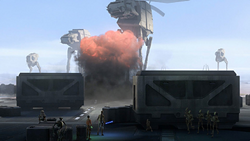
The Imperial Army fighting both Separatist holdouts and rebel cell forces
The Spectres undertook a supply run to the Agamar to obtain proton bombs from a Separatist transport ship. However, they were captured by a Separatists holdout led by the super tactical droid General Kalani. The droid general wished to end the Clone Wars on his own terms, and challenged the rebels to a battle that would decide the victors, but Imperial forces suddenly arrived and attacked the Separatist ship. The rebels and Separatists came to the conclusion that the Empire was the real victor of the Clone Wars, and decided to unite in order to escape the Empire.[42] While the Imperial Viceroy, Gar Saxon, discovered that the rebels were using the Concord Dawn system to avoid Imperial sector patrols. Saxon destroyed the Protectors' encampment on the third moon of Concord Dawn in an attempt to lure Fenn Rau back.[42] The Empire had planned to impose martial law on the planet Mykapo which rebels made efforts to evacuate rebel sympathizers. Upon arriving, the flotilla encountered a light freighter, which was engaged in a dogfight with an Imperial advance patrol calling themselves the Iron Squadron. Thrawn, who was aware of this Rebel presence in the system, dispatched a light cruiser to assess the situation, placed under the command of Admiral Kassius Konstantine in order to test the officer's questionable capabilities. The admiral was successful in crippling the Iron Squadron's freighter, prompting the crew with the exception of Mattin to escape aboard the Phantom II with the Spectres. The rebels returned with reinforcements from Phoenix Squadron to rescue Mattin. During the skirmish, Konstantine's cruiser was badly damaged, and most of his forces were destroyed. The rebels fled into lightspeed just as the Chimaera arrived in the system.[61]
Soon after, the rebels returned to Lothal and began an infiltration of the Imperial Armory Complex to obtain the blueprints for a prototype TIE fighter. However, their mission coincided with a visit by Grand Admiral Thrawn on behalf of Imperial High Command, who was investigating the high rate of sabotage within the factory. The rebels, however, escaped the factory with sensitive Imperial information with the help of the now disillusioned ISB Agent Kallus, who had become an informant for the rebellion. As a result of this rebel attack, Thrawn realized that the Empire had a traitor among their ranks.[62] Following this, there was an increase of the Imperial Navy presence such as capital ships in and around Lothal as part of Imperial orbital defenses.[63] Beyond the Lothal system, rebellious activities increased such as on Geonosis where Captain Brunson responded to a triggered proximity sensor and discovered the Spectres vessel Ghost on the planet who had saved both Saw Gerrera after his Partisans scout team were killed. Hoping to earn herself and her crew promotions, she attempted to destroy the rebels using TIE bombers, rocket troopers, and finally by trapping the rebels in an underground cavern in attempt to bury them alive. When she used her cruiser to block their escape, this backfired as the Ghost fired two proton torpedoes resulting in the destruction of her ship with the rebels who were able to recover images of the poison canisters that were used for the sterilization of Geonosis in order to show the Imperial Senate and rally more systems to their cause.[64] Thrawn later dispatched several E-XD infiltrator droids to search the Outer Rim for rebel bases. However, Kallus used the rebel identity Fulcrum to warn the base's Chief of Security Garazeb Orrelios about the threat. As a result, he and his fellow rebels Chopper and AP-5 managed to stop the infiltrator droid EXD-9 from infiltrating the rebel base on Atollon. They then turned E-XD9 into an improvised bomb that destroyed a Star Destroyer. Despite their efforts, Thrawn was able to narrow the search for the rebel base to 94 systems.[65] The Empire lost a local ally in the form of Viceroy Gar Saxon, the Emperor's Hand and puppet ruler of Mandalore. Gar Saxon was defeated during a duel with the rebel Sabine Wren on the planet of Krownest. Saxon's death triggered a power vacuum among the Mandalorians. Sabine then joined forces with her mother, Ursa Wren, and the former Protectors' leader Fenn Rau to reunify the Mandalorians.[66]
Continuing his investigation into the rebel mole, Grand Admiral Thrawn began screening the Imperial sector command staff within the Lothal sector] with the help of Imperial Security Bureau Colonel Wullf Yularen, a veteran of the Clone Wars. Thrawn summoned several Imperial officials including Agent Kallus, Lieutenant Yogar Lyste, Captain Brunson, and Commander Brom Titus for questioning aboard his flagship Chimaera. After learning that Thrawn was intercepting Kallus' transmissions, the Spectres and Rex mounted a mission to rescue Kallus. During the course of the mission, Kallus joined forces with the rebels to delete the planet Atollon, which hosted Chopper Base, from Thrawn's database. However, Kallus elected not to escape with the rebels and instead framed his colleague Lyste as Fulcrum. Thrawn learned of Kallus' deception but kept this information secret since he hoped to manipulate Kallus into uncovering the Phoenix rebel base.[67]
A growing rebellion
- "This is Senator Mon Mothma, I have been called a traitor for speaking out against a corrupt Galactic Senate. A Senate manipulated by the sinister tactics of the Emperor. For too long I have watched the heavy hand of the Empire strangle our liberties, stifling our freedoms in the name of ensuring our safety. No longer! Despite Imperial threats, despite the Emperor himself, I have no fear as I take new action. For I am not alone. Beginning today we stand together as allies. I hereby resign from the Senate to fight for you, not from the distant hall of politics but from the front lines. We will not rest until we bring an end to the Empire until we restore our Republic! Are you with me?"
- ―Senator Mon Mothma to the various rebel cells during the Declaration of the Rebel Alliance against the Galactic Empire
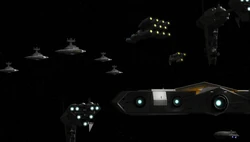
The Imperial Navy led efforts to counter the Rebel Alliance.
With full-scale rebellion on the horizon, Imperial Senator Mon Mothma would openly betray the Empire by seeking to unite the various rebellions cells into one organization. She began by firstly publicly condemning the reign of Emperor Palpatine after the Ghorman Massacre which led to Commander Vult Skerris leading the effort for her capture in the Archeon Nebula. However, the mission ended in failure, and she was able to escape. This led to her broadcasting a speech to rebels across the galaxy over Dantooine, which led to the formation of various rebel cells into the alliance to restore the Galactic Republic and, along with her resignation from the Imperial Senate, the beginning of a true united rebellion.[68] Soon after its foundering, the Rebel Alliance pressed on with the planned operation on Lothal by stealing clearance codes from the Imperial Security Bureau station on Killun 71 to allow their forces to mount a successful attack on the Empire.[69] However, the planned rebel attack on Lothal would not go forward thanks to Thrawn, who had discovered the location of Chopper Base, the headquarters of the Phoenix Group. Thrawn's fleet then blockaded Atollon and inflicted heavy casualties on rebel forces. Thrawn then launched a ground assault after an orbital bombardment. Meanwhile, Ezra, who had escaped the fighting, succeeded in enlisting the help of Clan Wren. In response, Governor Pryce dispatched Jumptroopers, but these reinforcements failed to stop the Mandalorians from destroying the last Interdictor cruiser. Despite Thrawn storming Chopper Base, the rebels and Imperials were attacked by an angry Bendu, an enigmatic being that was living on Atollon, who used his Force powers to devastate the rebel base before being subdued by Thrawn. The surviving rebel and Mandalorian forces then fled the battle as the Empire wiped out the Phoenix Squadron; however, the Empire was still unaware of the true scale of the Rebel Alliance.[70]
Meanwhile civil war raged on Imperial-occupied Mandalore, with the Rebel Alliance setting out to rescue Sabine father and Imperial prisoner Alrich Wren from Governor Tiber Saxon, Clan Wren were able to manage to rescue Alrich with the help of the rebels. In response, Saxon then unleashed the Arc Pulse Generator known as the Duchess against the Clan Wren forces, killing many. Sabine led the Mandalorians and rebels on a mission to infiltrate Saxon's Star Destroyer, which was above Sundari and were ambushed by Imperial forces, which resulted in the Mandalorians and rebels' success in destroying the weapon and Saxon's flagship.[41] The rebels continued their campaign and mounted successful raids on both Jalindi and the Faos Station. The Empire failed to stop both the Partisan and Spectre efforts, resulting in the loss of Commander Brom Titus and Captain Slavin. On Lothal, the Imperial Security Bureau conducted a successful raid against a suspected rebel cell allied with the Spectres.[71][71][72]
Galactic Civil War
- "Even though I've only been in active service for a few weeks, it has already become evident to me that the Rebel Alliance is a far larger and more dangerous group than official broadcasts have ever acknowledged. We do not operate as a peacetime military. Our preparations are more appropriate for a time of war."
- ―Jude Edivon
Eventually, the Alliance to Restore the Republic was formed in the few short years before the destruction of the Death Star at the Battle of Yavin, with the Alliance's Sixty-First Mobile Infantry striking at Imperial-held worlds such as Mygeeto, Crucival and Vir Aphshire for at least two months prior.[29]
Battle of Scarif
- "Sir, shall I begin targeting their fleet?"
"Lord Vader will handle the fleet. Target the base of Scarif, single reactor ignition."
"Yes sir."
"You may fire when ready." - ―General Hurst Romodi and Grand Moff Wilhuff Tarkin

Romodi and Tarkin discussing the Battle of Scarif
A group of rebels under the callsign Rogue One had captured the blueprints for the Death Star in 0 BBY during a growing rebellion, which had just been completed after nearly two decades of work on Scarif. They infiltrated the planetary shield in a stolen Zeta-class cargo shuttle and waged a guerrilla assault on the base's outskirts, drawing away Imperial forces, while the rebels could access the Citadel Tower. However, they received support from the Alliance Fleet under Admiral Raddus, whose forces engaged the Imperial Star Destroyers above Scarif and aimed to destroy the Shield Gate, marking the beginning of the five-year Galactic Civil War. Rogue One was able to transmit the stolen plans to the fleet above, but by the order of Grand Moff Wilhuff Tarkin, they along with Director Orson Krennic were eradicated by a low-powered blast from the arrived Death Star that destroyed the Citadel and surrounding area. By then, the Sith Lord Darth Vader's forces had destroyed the rebel ships that did not manage to retreat, but he failed to get the plans back as they were then transported to Imperial Senator and Princess Leia Organa on the Tantive IV.[73]
Search for the missing plans
- "I have traced the Rebel spies to her. Now she is my only link to finding their secret base."
- ―Darth Vader

The Death Star closes in on Alderaan.
Imperial forces commanded by Darth Vader captured one of the leaders of the Alliance and the one who possessed the plans, Princess of Alderaan Leia Organa—who, unknown to Vader, was his own daughter.[3][74] While nearly all of the old institutions of the Republic had been swept away in the intervening decades, this provided Sidious the opportunity to finally wipe away the last vestiges of the old democracy, and dissolve the Imperial Senate permanently. This brought governance of the various systems of the Empire directly under the purview of the Regional Governors and the Imperial Military.[1]
Organa's presence, and her refusal to give up the location of the Alliance's base, precipitated Grand Moff Tarkin's decision to test-fire the newly completed Death Star's primary weapon on her homeworld, Alderaan. In an instant, the Imperial Military's superweapon utterly destroyed the populous, influential world. In so doing, Tarkin hoped not only to force Organa to submit but also to strike fear into any others who sought to rebel against Imperial rule.[1]
Soon after the destruction of Alderaan, dubbed "the Disaster" by Alderaanian refugees, vigils for the dead were held on Coruscant's Level 3204, with many on the level having formerly lived on Alderaan. However, as soon as the circumstances behind the event became clear, the once-peaceful vigils turned into violent riots, with many calling for justice and revolution against the Empire. Imperial stormtroopers and Coruscant underworld police were soon called in to restore the peace, and began arresting and eventually relocating those who questioned Imperial rule.[75]
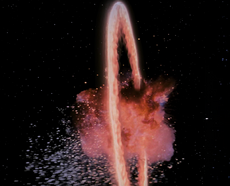
The Death Star, at the moment of its destruction
Eventually, Organa was rescued from the Death Star by the unlikely alliance of Han Solo, a smuggler, Jedi survivor Obi-Wan Kenobi, who sacrificed himself in his duel with Darth Vader, and her unknowing twin brother, Luke Skywalker. The group escaped the Imperial fortress and fled to the Alliance base on Yavin 4, pursued by the Death Star.[1]
At Yavin 4, the Empire and the Rebels engaged in a major battle, with the fate of the rebellion hanging in the balance. Despite destroying a great many of the Alliance's starfighters, the battle ultimately ended up a major defeat for the Imperial forces, when Skywalker fired the shot which destroyed the Death Star. This marked the Rebellion's first major victory against the Empire.[1]
An Empire besieged
- "We kept the skeleton of the Republic for nearly twenty years while the Death Star was constructed. Twenty years, my apprentice. All that planning is now a layer of dust orbiting around Yavin... Now, we no longer have the Senate to hold order. We do not have the Death Star to force it. Our greatest weapon is gone. Our production is in ashes. We are besieged. In all these years, we have never skirted closer to disaster."
- ―Darth Sidious to Darth Vader
Now viewing the growing Alliance as a credible threat, Palpatine issued a communiqué the morning after the Death Star's destruction ordering all ongoing ISB operations be superseded for the immediate detention of known and suspected rebel sympathizers. Admiral Kendal Ozzel ordered the fleet into battle readiness.[76] To keep the Rebellion off balance, the Empire engaged in rushed and scrambled offenses across the galaxy and raided spice worlds such as Kerev Doi in an attempt to cut off possible sources of income for the Alliance.[18] With major military redeployments occurring around the clock, the Imperial Military began to mobilize for a full-scale galactic war, while the Rebellion began to push into the populous Imperial Mid Rim in a failed operation that only months later would become known as the Mid Rim Retreat, its ultimate demise owing in large part to the Empire's numerical superiority.[29] Following losses at Phindar and Portocari two weeks following the Battle of Yavin, members of the Nashtah Squadron learned at the Zero Angle bar on the Bright Jewel Oversector Flight Base on Axxila III that the military would undergo a mass reorganization, rescinding the classification between Imperial Navy and Imperial Army pilots.[77] Unbeknownst to the Empire following the destruction of the first Death Star, the Rebel Alliance had successfully evacuated their base on Yavin 4 and was orbiting the remote world of Orto Plutonia in the Pantora system, located in the Sujimis sector, with the nearest Imperial presence being Moff Abran Balfour, who patrolled the world of Llanic situated at the intersection of the Llanic Spice Route and Triellus Trade Route. A brief skirmish erupted when Luke Skywalker, in the luxury yacht the Desert Jewel, attacked two TIE fighters assaulting a Kupohan ship. Unknown to Skywalker at the time, the ship was in reality carrying a Kupohan spy with vital intelligence regarding Drusil Bephorin, a Givin woman with a reputation for being able to slice into security systems at an astonishing rate and interpret encoded messages at breathtaking speed.[78] Desperately searching for the Alliance Fleet, the Empire sought to convince Drusil to use her cryptographic skills to aid them and kept her in a sort of luxurious imprisonment on Denon in an effort to sway her favor. Secretly, Drusil offered to join the Alliance as long as the rebels could successfully extract her family to the ocean world of Omereth, a task given to Major Bren Derlin. After a side mission to the Deep Core, Luke Skywalker, R2-D2 and Nakari Kelen successfully extracted Drusil after an elaborate chase across the galaxy, hampering the Empire's plans for a retaliatory strike against the Rebellion.[78]
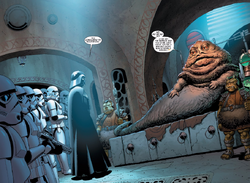
Vader concludes negotiations with the Hutt Clan.
In addition to rebel agents wreaking havoc internally, the Empire suffered desultory raids by rebel forces emboldened by their successful strike against the Death Star, with the rebels that destroyed it—Red Squadron—continuing to harass the Empire, especially during a mission above Giju where a transport carrying underground rebel leaders was evacuated from the planet. The Empire also continued to suffer setbacks from the Rebellion's golden boy, Luke Skywalker, including the trespass by the Jedi Purge survivor into the Temple of Eedit—an abandoned Jedi temple under guard of the Empire—on Devaron.[79] Despite the temporary turmoil instilled by the Rebels' bold strikes, the Alliance attempted even bigger operations to capitalize on its former success. Most notable was an attempt to assault, infiltrate and destroy Weapons Factory Alpha located in the Corellian Industrial Cluster on Cymoon 1, reputedly home to the largest weapons factory in the galaxy. In the meantime, the Empire opened negotiations with the Hutt Clan, led by Jabba the Hutt, to secure raw materials for Imperial Military production and secure their support for their expansion in the Outer Rim. The Rebels ultimately destroyed the factory, crippling Imperial production and causing another major setback.[80][81][82] For Vader's failure to stop the destruction of both the Death Star and the Cymoon 1 factory, Emperor Palpatine relieved him of much of his authority and assigned him to serve in the military instead of commanding it. As much of the Empire's military command had been lost with the Death Star, the Emperor appointed General Cassio Tagge, the Chief of the Imperial Army, to the rank of Grand General and assigned him command of Imperial Military matters due to his foresight to fear the Alliance Fleet and doubt the invincibility of the Death Star. The Emperor pressed the military to focus on conquering the Outer Rim and destroying the Rebellion—with the Death Star gone and the Senate disbanded, the Empire lacked efficient means to keep dissenting systems in line. Additionally, Imperial statisticians noted predictable increases in piracy following the Death Star's destruction. As a result, the military was to preserve order by any means necessary until the second Death Star was completed.[39] Under Tagge's command, the conquest of the Outer Rim progressed, with Tagge launching a significant crackdown on criminal elements that had gone unchecked in the past. The only criminal powers allowed to survive were the Hutts, per Vader's agreement with Jabba. The destruction of competitors also allowed the Hutts to capitalize on "new markets" supplied by the Empire.[83]
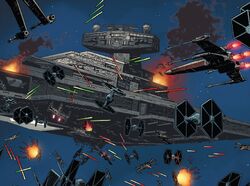
The rebels had began to make a push to defeat the Empire.
While the Rebellion made a drive to defeat the Empire, Vader meanwhile searched for Luke Skywalker.[84] The Empire attempted to pin down rebel activity, but were unable to stop them from seizing control of the Harbinger from the grip of the Imperial Navy.[85] However, the Empire started a counterattack and prevented rebel guerrilla and military desultory raids that had occurred in the aftermath of Yavin.[86][87][88] Further Imperial success came on the mineral planet Crait, where the Empire confronted the Alliance after an attack on the Alliance Fleet as they searched out a possible new rebel base.[89]
Mid Rim Retreat
- "[…] Our forces just chased half the Alliance out of the Mid Rim. How many other rebel ships managed to escape an engagement in this sector after sustaining damage—in the past week, say? How many others need repairs, as well? It's your hunt."
"It's our hunt. All of ours!" - ―Captain Tabor Seitaron and Prelate Verge on tracking down the rebel ship Thunderstrike during the Mid Rim Retreat
Following the destruction of the first Death Star, the Rebellion embarked on a massive military campaign to liberate hundreds of worlds under Imperial control by pushing into the heavily populated Mid Rim. With thousands of starships, hundreds of battle groups and dozens of worlds involved in the operation, it was initially met with stunning success as Imperial forces, unprepared for such a large-scale operation and shattered from the recent shake-ups in the Imperial hierarchy, fell back from world to world, allowing the Rebellion to press further into Imperial space. Taking the factory-deserts of Phorsa Gedd and the Ducal Palace of Bamayar, the Rebellion's advance gradually slowed as Imperial resistance stiffened. Eighteen months into the operation, fearing to overextend the fleet and occupied with the consolidation of worlds now under Rebel control, High Command ordered for the defense of occupied territories, and shortly thereafter the slow withdrawal of Alliance military resources back towards the Outer Rim.[29]
Assaulting Echo Base
- "Make ready to land our troops beyond their energy field, then deploy the fleet so that nothing gets off the system."
- ―Darth Vader
While the loss of both Tarkin and the Death Star itself were significant, Imperial resolve toward putting down the rebellion only increased. For the next three and a half years, Imperial forces under the direct command of Darth Vader relentlessly pursued the Alliance. While the hunt was personal for Vader, having learned that the young rebel Skywalker was actually his son, the Imperial Military nevertheless scoured the galaxy with Imperial probe droids.[9]
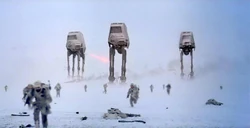
The Empire crushes the Rebellion on Hoth.
Eventually, the Empire's search came to fruition when one of its probe droids located the Alliance's new base on the ice planet Hoth. The massive Imperial fleet, led by the command ship Executor, arrived in the system and deployed ground forces at the Moorsh Moraine, a glacial feature on the planet in preparation for a major assault on the Alliance forces at Echo Base. Overwhelmed, the rebels were forced to flee, and the Empire claimed a decisive victory.[9]
The Imperial pursuit of the rebels, however, did not stop at Hoth. The Imperial fleet continued to chase down the fleeing rebels, pursuing Leia Organa and Han Solo into the Hoth asteroid belt. Though Solo's ship, the Millennium Falcon, eluded Imperial pursuit, Vader engaged the services of bounty hunters to track down the fleeing Alliance leadership.[9]
One of these bounty hunters tracked Organa and Solo to Cloud City on Bespin, enabling Imperial forces to capture them and lay a trap for Luke Skywalker. The trap was eventually sprung, and Skywalker learned of his true relation to Vader, but the Imperial forces found themselves betrayed and, at least initially, overwhelmed by Cloud City's local authorities. The rebel leaders escaped Imperial custody again, but not without cost. Skywalker was maimed in a duel with Vader, while Solo was frozen in carbonite and handed over to the bounty hunter. Battered and bruised, the Alliance was once again in flight from pursuing Imperial forces.[9]
Splintering of the Rebellion
- "Since the destruction of the Alliance base over fifteen rebel outposts and seven members of the enemy leadership have surrendered. Emperor Palpatine is reportedly considering public trials for select combatants in the hope that others—witnessing their fair treatment—will follow their example and turn themselves in."
- ―Imperial HoloNet News
Following the disastrous Battle of Hoth, the Alliance Fleet was scattered across the galaxy, and the absence of clear orders and the condition of Alliance High Command put the movement into its most critical stage in the war effort. With Imperial forces required to maintain the Mid Rim border and combat active war zones, vast numbers of Imperial forces from the Core Worlds were deployed to finally quash the Rebellion in the Outer Rim. This redeployment, however, left the Core's defenses enervated if only by a slight margin. Knowing the Empire's reliance on the Imperial shipyards at Kuat and their vital importance in planetary containment and fast infantry deployment, the Rebel Sixty-First Mobile Infantry launched Operation Ringbreaker, an initiative designed to destroy the Empire's orbital facilities at Kuat. Ultimately, the plan faltered and ended on Sullust owing to logistical concerns.[29]
Conflict at Endor
- "Everything that has transpired has done so, according to my design. Your friends, out there on the sanctuary moon, are walking into a trap, as is your Rebel fleet. It was I who allowed the Alliance to know the location of the shield generator - it is quite safe from your pitiful little band. An entire legion of my best troops awaits them. Oh, I'm afraid the deflector shield will be quite operational when your friends arrive."
- ―Emperor Palpatine explaining his plan to Luke Skywalker during the Battle of Endor
Six months after the Rebellion's catastrophic loss at Hoth, the Rebel Fleet split into small fragments across the galaxy in an attempt to avoid another propaganda victory for the Empire, further extending the Imperial fleet in an effort to engage them. Despite its previous advantages following the Battle of Yavin, the Rebellion was sitting on a knife's edge after learning of Emperor Palpatine constructing another battle station. Following the loss of the first Death Star, the Emperor made clear his determination to create another planet-shattering space station, this time more powerful than the first. Utilizing S-thread boosters to carve a secret hyperspace lane through the Outer Rim, the Emperor planned to destroy the rebels in a doomed engagement over the forest moon of Endor, construction site of the Death Star II, which, unbeknownst to the rebels, had a fully operational superlaser. Following the presumed destruction of a sizable portion of the Alliance's military capabilities, the Emperor planned to deploy some of the largest invasion fleets seen in centuries to blockade the known rebel strongholds of Mon Cala and Chandrila until the Death Star could destroy them, successfully eliminating any hope of a successful galactic resistance and thus permanently ending the Alliance to Restore the Republic through sheer terror and intimidation.[90]
With the Alliance Fleet assembling over Sullust, the Emperor decided to proactively approach the Rebel problem. Rather than guard the station's secrets, as with the first Death Star, Sidious opted to leak just enough information to bait the Alliance into striking at the station before it was completed—including the fact that he would be overseeing the final stages of the station's construction personally.[74] After the Bothan spynet successfully transmitted intelligence regarding the Empire's new and improved Death Star to Alliance High Command, an emergency summit was held on the remote trade world of Zastiga, far from the Galactic Core. There, Rebellion leaders and generals were to be informed of the construction of the second Death Star located over Endor which, they knew, had to be destroyed before it became operational. Needing to buy time for the scattered fleet to assemble over Sullust, Princess Leia Organa devised a strategy—Operation Yellow Moon—to divert Imperial attention to her instead of the upcoming mission to Endor.[90] Ultimately, with the successful completion of Yellow Moon, the Rebel Alliance had gained valuable time for its now consolidated fleet to finally be able to strike at an incomplete Death Star.[90]
Unknown to the Rebels, large portions of the Imperial Starfleet had already begun massing in the Hudalla system, while Imperial engineers had ensured that the new Death Star's main weapon was fully operational. Eventually, Imperial Military command had discreetly moved the gathered warships to a staging point on the far side of Endor's moon, where the Death Star was orbiting. Simultaneously, a legion of Imperial troops was deployed on the surface to stop any attempt at sabotaging the station's ground-based SLD-26 planetary shield generator, which neutralized any attempt at directly assaulting the station.[74]
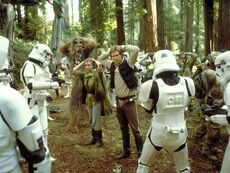
The Alliance strike team is captured by the Emperor's troops.
Imperial intelligence reports indicated that Sidious' trap was indeed well underway when it was discovered that the Rebel fleet was massing at Sullust, as a staging ground for their strike at Endor. Per the Emperor's design and command, Imperial Military authorities were ordered to ignore the buildup so that the Rebels would commit their entire force to a doomed attack. When the Alliance fleet arrived en masse, the Emperor's trap was sprung. The Rebel ground forces had taken the bait and been captured, allowing the Death Star's shield to remain active, while the Imperial fleet moved into position to trap the Rebels. With the Alliance Fleet trapped between the bulk of the Imperial fleet and a shielded, fully operational Death Star, victory for the Empire seemed assured.[74]
On the surface of Endor, the tables were turned on the Imperial forces when they were unexpectedly attacked by the planet's indigenous Ewok population, who had allied themselves with the Rebels, giving the Alliance ground forces a free hand to destroy the Death Star's shield generator. With the shield down, Alliance starfighters were able to launch an assault on the Imperial station's reactor core.[74]
The Rebel fleet and the Imperial fleet engage each other.
Meanwhile, aboard the station, a blow of an entirely different kind was struck against the Empire. A captive Luke Skywalker, now a Jedi, convinced Darth Vader to turn on his master. Vader—once again Anakin Skywalker—seized the Imperial head of state and hurled him down a shaft to his death. Soon after, the Rebel starfighters successfully attacked the Death Star's reactor core. The station was destroyed—like its predecessor, lost with all hands.[74] With the loss of both the Emperor and his right-hand man, Vader, the destruction of the Death Star itself, and significant losses inflicted on the Imperial fleet, the Imperial remnants were forced to withdraw to the Annaj system.[91] The Empire had suffered a decisive defeat.[74]
Fragmentation of the Order
- "This isn't some kind of inspirational story. Some scrappy, ragtag underdog tale, some pugilistic match where we're the goodhearted gladiator who brings down the oppressive regime that put him in the arena. They get to have that narrative. We are the ones who enslaved whole worlds full of alien inhabitants. We are the ones who built something called a Death Star under the leadership of a decrepit old goblin who believed in the 'dark side' of some ancient, insane religion."
"Were this a better day, you'd be executed for treason, General Shale."
[…]"Then why do governors turn away from us every day? Why do we lose more ships every week? Why do we see holovids of freed worlds throwing parades and tearing down statues? They did so much with so little, Pandion. You misunderstand our place in history." - ―General Jylia Shale and Moff Valco Pandion

The Rebel assault against the Imperial outpost on Endor, the day after the Death Star II's destruction
With the destruction of the Death Star and death of the Order's totalitarian ruler, many worlds across the galaxy began to celebrate the Empire's defeat over Endor with the incorrect notion that the war was over.[92] Despite being at the heart of the Galactic Empire, the Imperial Center would also see tumultuous festivities by its populace, eventually leading to a riot breaking out in Monument Plaza that would eventually coalesce into a full-scale civil war.[10] Owing to the lack of a clear system of succession following the Emperor's death, chaos gripped the galaxy as former Imperial expansionism stalled. Members of the Imperial Council and various other military warlords attempted to grab what territories they could, while tailored propaganda messages often contradicted one another. Some refused to legitimize the New Republic, and thus banned referring to it by name. Others portrayed it as a monstrous terrorist organization, swallowing up Imperial worlds for plunder and conquest, while still others refused to even acknowledge the Emperor's death for months.[6][10] Governor Adelhard, who was in charge of the Anoat sector, attempted to downplay the Empire's defeat over Endor and cover up the Emperor's death. Shutting down all travel and communications into and out of the Anoat sector, Governor Adelhard established the Iron Blockade and formed his own remnant faction. Citizens who dared to fight back and speak of so-called rumors of the Empire's defeat were hunted and eliminated by Commander Bragh and his Purge Troopers.[93] While some such as Grand Moff Lozen Tolruck of Imperial territory G5-623 on Kashyyyk suggested that the Emperor had escaped the Death Star II through miraculous means, others claimed the even wilder notion that the Emperor was still leading the Empire from beyond the grave.[10]

The Alliance assaults Imperial positions on Sterdic IV.
With the Empire fragmented, the Rebel Alliance embarked on numerous campaigns such as the Beltire Liberation and the Battle of Cawa City[94] to capitalize on its stunning success over Endor, resulting in numerous Imperial defeats. Twenty days after Endor, the posthumous contingency plan of the late Emperor known as Operation: Cinder was delivered to numerous Imperial captains by messenger droids. The plan ordered the scouring of his homeworld of Naboo along with at least a dozen other worlds such as Burnin Konn, Candovant, Abednedo, and Commenor with climate disruption arrays. Utilizing N-1 starfighters dating 36 years earlier to the Battle of Naboo, the Alliance managed to destroy the satellites with the aid of an MC80 Star Cruiser and the Alliance Fleet. Despite the Order's defeat over Naboo, the Empire still attempted the operation on numerous worlds in the three months following the Battle of Endor.[95][96]
After the Battle of Endor, illicit holovids of the Emperor's defeat over Endor and rebel propaganda detailing the liberation of worlds such as Naboo disseminated throughout the galaxy, with many risking arrest and execution for spreading what the Empire deemed lies. However, the increasing view that the Empire was weakened, reinforced by the insistence of authorities claiming otherwise, prompted thousands of planets to join the Alliance, while Imperial Military defections steadily increased. In order to counter the reports of the Emperor's demise, a proxy actor was installed in his place, but some citizens noticed slight differences in the facsimile. Eventually, the truth of the Emperor's demise became known to the general citizenry. Declarations of a new Emperor were announced almost every day, but none were able to consolidate any substantial power. Former aide to Emperor Palpatine since the Clone Wars, Grand Vizier Mas Amedda attempted to keep the Empire together while splinter fleets and other Imperial officials fought each other to support the various claimants to the throne.[18]
Eventually, the Galactic Empire had to contend with the New Republic, a rival galactic government formed in the wake of the Rebel Alliance's victory at Endor. Suffering a string of defeats against the Republic including the loss of Sevarcos and Malastare, along with a failed attempt to restart the former Separatist droid foundries on Geonosis, the Empire gradually began to crumble. Self-appointed Grand Moff Valco Pandion and other military leaders began to jockey for power, while corrupt sector governors accepted payments for the Republic's allocation of Imperial ships or sued for peace at the earliest convenience.[12] The captains of two of the Empire's thirteen Executor-class Star Dreadnoughts even surrendered to the New Republic.[10]
With most of the Empire's veteran troops killed on the second Death Star or Vader's command ship Executor, military paucity and tactical clumsiness soon hampered the Empire's efforts at a concerted strike against the Republic. The Imperial Military suffered numerous losses of warships and troops, and expended more ordnance than it could produce fighting Republic forces. This ultimately led to a supply deficit forcing Imperial-class Star Destroyers to make do with an inadequate supply of TIE/LN starfighters and resulted in both the Imperial Navy and Imperial Army utilizing undertrained personnel pulled early from the numerous Imperial academies. Consequently, many planets were either captured by or seceded to the New Republic. With the loss and failure of three invasions of the Mid Rim world of Naboo, birthplace of Palpatine and thus an influential rallying point for the New Order's shattered forces, the Empire retreated to numerous fallback positions on strategically unimportant worlds such as Naalol, often drawing the New Republic into long and indecisive conflicts, forestalling its slow push toward the Core Worlds. Despite these efforts, the Republic had already established its capital on Chandrila, a planet located within the Core.[12]
Purge on Akiva
- "The rebels—because that's what they are, rebels, criminals, deviants—did what they did with almost no war machine in place. Insurgents, all of them. They managed a few lucky shots with their slingshots but we still have the ships, the men, the training. The money."
- ―Moff Valco Pandion
Despite the lack of a clear chain of command, old loyalists and a common fear of the rising Rebellion kept a vague semblance of unity between the surviving Imperial forces. Existing on a knife's edge, many officers wondered when someone of prominence would break away from commonality and begin to overtly act against the greater body, ushering in chaos and anarchy. To avoid this, the surviving Imperial leaders and their military forces converged on the Outer Rim planet of Akiva in an attempt to evade New Republic detection and stabilize the remaining factions of the Empire in the months following Endor, with various portions of the Outer Rim still occupied by Imperial forces. During the Akiva summit, various Imperial delegates discussed the future of the Empire in the aptly named Imperial Future Council.[12]
Amid the conference, the various Imperial leaders were divided over how the Empire should deal with their newfound situation, and whether or not it would be wise to continue the war or enter into a state of cold war. Additionally, the continued funding of the Imperial Military was hotly disputed, with some arguing that plundering the InterGalactic Banking Clan and other monetary bodies would plunge the galaxy into an economic depression. The notion of abandoning the Empire's dark-side devotion was even discussed, while Imperial Advisor Yupe Tashu—a longtime admirer of Palpatine and dark-side cultist—suggested sending the Imperial remnants to the outskirts of the galaxy to search for the source of the dark side. With the more pressing objective to organize and thus strike out against the New Republic before it could grow any stronger, the delegates soon began discussing who should lead the Empire as the new Galactic Emperor.[12]
Before any real progress could be made, Akiva was ultimately liberated after a New Republic fleet arrived, forcing the Imperials to scatter once more and resulting in Akiva being the first Outer Rim planet to formally join the New Republic. In reality, Imperial Fleet Admiral Gallius Rax, a warlord who controlled one of the larger fragments of the fallen Empire, had been secretly manipulating the entire event in an attempt to weed out those that he saw as weak in the Empire under the guise of "The Operator," and had been giving the New Republic secret Imperial intelligence for quite some time following Endor.[12]
War of Attrition
- "This is Grand Admiral Rae Sloane, commander of the Imperial Navy and de facto leader of the Galactic Empire. The Empire remains vigilant in combating the anarchist criminal government calling itself the New Republic. The dream of a safe, sane, and unified galaxy did not die with the glorious Emperor Palpatine. The Galactic Empire continues to march forward, tirelessly diligent in its quest to return order and stability where none before existed. Meanwhile, the New Republic continues its own mission to destroy what we have built together. Crime has returned to the galaxy tenfold as the underworld dynasties have regained dominance over worlds once kept free of their toxic influences by the Empire. Supply lines have been cut, and many worlds are now starving without adequate food. The corrosive influence of the New Republic has caused a seemingly insurmountable loss of jobs, income, and even lives. But fear not. The Empire remains, as sure as a mountain, as certain as the stars across all the systems. We will defeat the insurgency. We will make this false government pay for its crimes against you. Even now we are building new ships, new bases, and founding new technologies to keep you safe. The Empire is coming. We will deliver you from harm. And we will strike back against our enemies. Remain calm. remain loyal. With true hearts, victory for us—and for the whole galaxy—will soon be at hand."
- ―Grand Admiral Rae Sloane, in an OIP propaganda piece
Roughly two months after the Battle on Akiva, the Galactic Empire's territorial possessions were rapidly shrinking. Numerous systems left the Empire or waged their own resistance movements, declared their independence, and established their own fiefdoms or joined the New Republic. Criminal syndicates flourished in this atmosphere of conflict, especially the reptilian pirate Eleodie Maracavanya, who had captured the Super Star Destroyer Annihilator and used it to forge her own criminal empire. Various moffs and governors rebelled against the Empire, while more and more people asked what exactly the Empire was. Agencies, personnel, and whole planetary systems started to drift apart, each adopting different tactics and methods for combating the New Republic, and each other.[10]
Grand Vizier Mas Amedda was acting as Emperor after Palpatine's death but in reality was nothing more then a proxy Emperor who held little real influence beyond the throneworld of Coruscant with his reign being met with whole sectors of Coruscant started to revolt and was entrenched in government districts. Rax refused to allow Sloane to send reinforcements to Amedda as the throneworld had no place in his vision of a renewed Empire. Sometime later he met with Chancellor Mon Mothma and Senator Leia Organa, who refused his surrender during a meeting on Velusia and demanded he instead find a way to gain full control of the Galactic Empire and ordering him to work towards signing a treaty of surrender to clear his name.[10]
Upon his return to Coruscant, Amedda considered suicide by jumping off of one of the Imperial Palace's balconies. However, he changed his mind after meeting Sloane. After Sloane inquired about the identity of Fleet Admiral Gallius Rax, Amedda decided to strike an alliance with her. In return for assisting her investigation into Rax's background, Amedda agreed to align with Sloane. Sloane believed in the New Order that developed after the Clone Wars as opposed to Rax, who wished for a renewed Empire ruled by the dark side as it was under Darth Sidious. Following their agreement, Amedda revealed the droids that contained the information she sought were aboard the wreckage of the Imperialis on the junk moon Quantxi.[10]
As the war grew more desperate, TIE fighter pilots even began suicide attacks on entrenched Republic positions, and various commanders executed wholesale massacres of native populations. The HoloNet, now free of Imperial censorship, brought such atrocities to the public spotlight. Other Imperial officials went AWOL and holed up in distant, hyper-secure outposts to avoid the Republic Tribunal and its sentencing of Imperial war criminals. Additionally, the Emperor's Super Star Destroyer, the Eclipse, had disappeared from the galaxy.[10]
Gallius Rax's hour
While the Empire appeared to be receding as the New Republic grew in size, Fleet Admiral Gallius Rax—who had earlier staged the IFC to eliminate rivals in his ascent to power—consolidated more and more systems to his cause. Publicly, Grand Admiral Rae Sloane was recognized as the de facto leader of the Empire's largest remnant faction and Imperial Navy, but was, in reality, nothing more than a pawn in Rax's game. Despite having been a personal friend to Palpatine, Rax saw the Empire of old as weak, corrupt, and overripe. To him, by allowing the New Republic to gain ground, he not only eliminated potential competition but consolidated the leftover pieces of the Order.[10]
Unbeknownst to the Republic, Rax had secretly moved hundreds of Star Destroyers and thousands of lightships to hide in the Vulpinus, Almagest, Recluse's, Queluhan, Ro-Loo Triangle, and Inamorata nebulae following Endor. With the shipyards of Kuat, Xa Fel, Anadeen, and Turco Prime already lost or contested, Rax planned to use the Empire's last foothold in the Outer Rim as a "strangling cord" to tie around the New Republic. While the Empire of old relied on third-party corporations to produce its military hardware, Rax had nationalized all aspects of the production chain to be solely Imperial. To conclude his plan, Rax founded the Shadow Council after rescuing the final member of the council, Brendol Hux, from Arkanis. This "Shadow Council" was to serve as a secret advisory board composed of the "best and brightest," with the ultimate motive of secretly guiding the Empire into a new golden age.[10]
Roughly three months after the Battle of Akiva, Rax sent Rae Sloane on a mission to the New Republic's capital with the overtures of signing a peace treaty who reassured her that her mission to Chandrila would cement her role as Emperor. The signing coincided with the New Republic's celebration of Liberation Day, a holiday celebrating the release of captives from the Imperial prison Ashmead's Lock on Kashyyyk, with many of the captives having been held in suspended animation since the days of the early Rebellion. In reality, the survivors were a part of an elaborate assassination scheme by Rax, executed by his lackey, Windom Traducier—an undercover Imperial operative posing as a Senate Guard—by utilizing inhibitor chips that had been installed within the survivors' brains. As the New Republic officials shepherded the liberated prisoners and their families onto a stage, Rax ordered Grand Moff Randd to prepare the Imperial fleets to travel to a series of coordinates, which turned out to be the planet Jakku. Rax also convened a meeting of the Shadow Council.[10]
The survivors then attacked and fired on the crowd after the chips' activation by Traducier, with the survivors targeting Chancellor Mon Mothma and various members of the Republic military during a dedication speech to their rescue. Watching the carnage from the balcony, Sloane realized that this terror attack was the "attack" Rax had foreshadowed to her. Already disagreeing on Rax's methods for administering the Empire, Rae announced her intention to confront Rax aboard the Ravager to her aide, Adea Rite, a secret supporter of Rax. As a result, Rite attempted to assassinate Sloane, but she managed to escape off-world. Traducier then freed Tashu from the Republic and told him that he still served the late Emperor Sheev Palpatine even after Rax had given himself the title of Emperor. The attacks demoralized the New Republic but failed to turn the tide of the war against the Empire, which lost Kashyyyk following an uprising led by Han Solo and Chewbacca.[10]
Claiming that Sloane had been captured during the attack on Chandrila, Gallius Rax proclaimed himself Counselor to the Empire and took over leadership of the Imperial remnants. When Borrum asked why they were traveling to the barren world of Jakku, Rax responded that he wanted to "test" the mettle of his new armada above the planet.[10] In secret, Rax planned to eliminate the other Council members with the exception of Brendol Hux as part of the Emperor's posthumous Contingency. The late Emperor had decreed prior to his death that the Empire would not be allowed to outlive him because it had failed to protect its leader.[97]
Meanwhile, Sloane joined forces with the former rebel Brentin Lore Wexley to hunt down and kill Rax. While Sloane had received information from the bounty hunter Mercurial Swift that he had discovered that Rax had come from Jakku, the two then traveled to the desert planet. After landing, Brentin and Rae visited a bar owned by Corwin Ballast in an attempt to find information about Rax. Ballast yielded no information but the pair soon got their answer when they witnessed Rax's Super Star Destroyer Ravager exiting hyperspace with his massive Imperial armada, the Emperor had returned home.[10]
Showdown on Jakku
- "With the death of our beloved Emperor, our own Empire was cast into disorder. It gave strength to the illegitimate, and emboldened them with a fraudulent claim of bringing peace and justice to the galaxy—and yet, for so long, who have been the champions of peace? The only war visited upon the galaxy has been the one brought by the criminal Rebel Alliance. Scattered and lost, we could have perished. After attacking Chandrila and injuring the fraudulent politicians who seek to steal the sanctity of our galaxy, I brought us here to Jakku, unifying our people and our powers in this faraway world—a hard world that has tested our mettle and forged us and sharpened us into a stronger blade. A blade with which we will slit the throats of the traitors that crawl on their bellies toward our door. Soon they come! Soon they try to finish what they started. They want to end the Empire. They want to set up as a tumor on a healthy body, leeching the blood while growing fatter like a parasite. They deny our legitimacy. They lie about the stability and sanity we created for the galaxy. For those are their truest weapons: deception and delusion. We must not give in. We must not believe that they are right. We must see them as they are!"
- ―Gallius Rax's speech
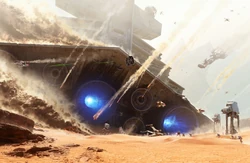
The Imperial-class Star Destroyer Inflictor crashes onto the surface of Jakku.
For several months, Counselor Rax's forces waited on Jakku for the New Republic to launch their attack. Under Rax's leadership, the Imperial remnant forces on Jakku was tested and exhausted by the harsh conditions on the desert world. Rax claimed that hardship was part of the purification process of building a stronger and ideologically purer Empire. In line with Rax's cult-like philosophy, Imperial training became harsher and more savage while dissidents were harshly treated. With the help of Brendol Hux, Rax kidnapped local orphans and street children and trained them into a force of child killers led by Brendol's young son Armitage Hux.[98]
Meanwhile, New Republic forces launched mopping-up operations against Imperial holdouts on Kashyyyk and Cloud City. Norra Wexley and her team eventually discovered the Imperial presence on Jakku. Her son Temmin Wexley and the former Imperial loyalty officer–turned–New Republic operative Sinjir Rath Velus managed to warn Princess Leia and Chancellor Mothma. However, the New Republic's Galactic Senate was deadlocked on the matter of interceding on Jakku due to the machinations of the Black Sun and Red Key crime syndicates. After Han Solo, Sinjir, and his team helped secure the necessary votes, the Senate voted to send New Republic forces to Jakku.[98]
A year and four days after Endor in 5 ABY, the Empire and the New Republic fought a major battle over and on the Inner Rim planet Jakku as the rebels sought to defeat the Empire and expand their territory into a vital sector in the galactic war. With the Empire controlling most of the galaxy's major shipyards, the Republic sought to expand their fleet by capturing Imperial vessels, along with destroying a secret Imperial weapons facility on the planet.[99][13] The battle took place in space and the barren deserts of Jakku as New Republic forces sought to destroy the Imperial presence on the planet.[98]
At first, the battle was in the Empire's favor. Under the command of Grand Moff Randd, the Imperial fleets formed a tight defensive formation around the Super Star Destroyer Ravager. This impenetrable formation blunted the New Republic naval onslaught and enabled the Ravager to periodically bombard the New Republic fleet. On the ground, General Hodnar Borrum's forces put up a stiff resistance against the New Republic. As the battle raged, Counselor Rax, Adviser Yupe Tashu, Brendol and Armitage Hux, and the child soldiers traveled to the Jakku Observatory. There, Rax had a replica of the Emperor's yacht Imperialis waiting to take them to secret coordinates in the Unknown Regions. The Observatory also concealed a borehole which led to Jakku's core. Rax and Tashu planned to initiate a dark-side ritual that would cause the planet to explode, destroying the orbiting Imperial and New Republic fleets as part of the Contingency.[98]
The tide of the Battle of Jakku turned in the New Republic's favor when the New Republic Captain Kyrsta Agate's Starhawk-class battleship Concord took advantage of a gap in the Imperial formation to bombard the Ravager. Through the Concord was crippled by the Ravager, she managed to drag the larger ship down to Jakku's surface using her powerful tractor beams. With the Imperial command ship destroyed, New Republic forces were able to outflank the Imperial forces on all fronts. With the battle turning against the Empire, the surviving Imperial forces began pulling ships onto the planet's surface utilizing their tractor beams, killing most of the occupants in an instant.[98]
Rax's plot to detonate Jakku was ultimately foiled by the combined efforts of Grand Admiral Sloane and her former adversaries Norra and Brentin Wexley. Following Rax's death, Sloane inherited the final stages of the Contingency and accompanied Brendol, Armitage, and the child soldiers into the Unknown Regions where they found the Eclipse, which had in fact been sent into hiding. Meanwhile, Grand Vizier Amedda escaped house arrest with the help of a group of child resistance fighters known as the Anklebiter Brigade. After initiating contact with Chancellor Mothma, Amedda would go on to sign the Imperial Instruments of Surrender and the Galactic Concordance with the New Republic; this process ended the Galactic Civil War.[98]
Galactic Concordance
- "In the month since the Battle of Jakku, the Empire has attempted no further large-scale offensives. Sources report all Imperial vessels within the Core and Inner Rim staying within the boundaries defined by the treaty. A few prominent members of the Provisional Senate have speculated that the New Republic's war with the remnants of the Empire has finally come to an end and that a final surrender may be imminent. However, in her address today, the chancellor warned that all planets should remain on high alert, and that the New Republic Starfleet should be kept on a war footing for the foreseeable future."
- ―A news holo a month following the Battle of Jakku
The Empire lost the Battle of Jakku and was forced to surrender to the New Republic.
Ultimately, the Imperial counteroffensive was decisively defeated and the Empire forever changed as it was pushed back to a handful of sectors on the fringe of the Outer Rim, containing only a small fraction of the galaxy's population and industrial base. These sectors were a heavily fortified final redoubt, and the New Republic deemed that they posed too minor of a threat to justify the high cost in life that liberating them would require.[13] The New Republic then forced Grand Vizier Amedda to capitulate the Empire and settle for the Galactic Concordance on Chandrila, a humiliating armistice agreement which imposed strict disarmament plans and punishing reparations on the Empire. Treaty stipulations included outlawing the recruitment and mobilization of the Stormtrooper Corps, paying heavy war reparations, adhering to strict disarmament treaties, abandoning the numerous Imperial Academies scattered across the Empire, banning torture, and ceding its capital of Coruscant to the Republic. Chancellor Mothma then issued another declaration designating all surviving officers war criminals, though she granted conditional pardons to all civilian functionaries including Amedda, provided they complied with the Concordance. While regulating what remained of the Empire's once-mighty military-industrial complex, thus limiting its ability to wage war, the treaty did permit elements of the Imperial Navy to remain in pre-determined boundaries in the Core Worlds and the Inner Rim. At the command of the Republic, they were recalled to the Core; however, some did not obey.[98][13]
The Republic then began arriving in the remaining Imperial sectors to announce the signing of the Concordance,[100] such as in the Velcar sector, where Governor Ecressys had already fled into the Western Reaches.[6] Meanwhile, a provisional government on Coruscant was permitted;[98] this ultimately led to the Republic annexing the former Imperial capital,[100] while Amedda was also allowed to resume his rule on Coruscant. However, Republic officials oversaw his administration to ensure that the Vizier remained little more than a powerless figurehead.[98]
Despite the Concordance, Imperial splinter factions existed and did not grasp the new political landscape, such as remaining Imperial ground forces on Jakku, who held out for several months before surrendering; the surface of Jakku would remain littered with wreckage from the battle for decades to come.[13] The New Republic also had to contend with the scattered Imperial remnants who did not recognize the Empire surrender across the galaxy,[98]
Fall of the Empire
- "Is the world more peaceful since the revolution?"
- ―"The Client"
Remnant Stormtroopers were active in the years after the Galactic Civil War.
With the fall of the Empire, most Imperial territories were assimilated into the New Republic; the new galactic government,[98] others that opted not to join the Republic were restructured as scattered remnants whom remained loyal to Imperial ideology,[13] these remnants attempted no further large-scale offensives a month after the Battle on Jakku, while some of the former Imperial Navy retreated to the edge of the Unknown Regions. This included Grand Moff Randd's and Commander Nash Windrider's forces, who had regrouped for renewed offensive against the New Republic.[18] With the factionalism falling over the fallen Empire,[13][18] it remnants were placed within defined boundaries under Imperial sovereignty,[16] as fragments of the former regime gained footholds on distant worlds, securing what little power they had left.[101]
Meanwhile some Imperials discreetly retreated from the known galaxy, relocating to the Unknown Regions by using information derived from the survey teams and droids that Emperor Sheev Palpatine had sent to explore the region before as well as from Thrawn.[98] The Attendants, a retinue of mute alien navigators, assisted the Imperial nobles, technologists and officers[102] warlords[13] in crossing the ancient hyperspace trails.[103] Following coordinates that had been transmitted to other Imperials deemed loyal to the late Emperor, the Imperialis, piloted by a sentinel, embarked on a journey from Jakku that took several months and involved taking several hyperspace jumps through a maze of black holes and superstorms. Once reaching the Eclipse, Grand Admiral Sloane resolved that she would build a new Empire stronger and purer.[98]
Eventually political hard-liners, who presided over what remained of Imperial power, refused to acknowledge the defeat, which developed into an uneasy relationship with the Republic, considerable enough to concern the Republic authorities. The hard-liners after a period would relocate from Imperial Space to the Unknown Regions,[13] where they would join Sloane and the growing First Order, which was a hermit state and military junta influenced by New Order ideology.[6]
Legacy
- "Through the ages... I've seen evil take many forms. The Sith. The Empire. Today, it is the First Order."
- ―Maz Kanata

Stormtroopers of the First Order
After the collapse of the Galactic Empire after the war and with many members of the political, military, and scientific establishment escaping into the Unknown Regions following the Galactic Concordance, the New Republic maintained an egalitarian policy of peaceful coexistence with many of these new galactic governments, which comprised former territories led by Imperial governors, some of which sought to join the Republic.[100] While the Empire, the heroes of the Rebellion, and the tragedy of Alderaan would be remembered by the generation conceived after the destruction of the Death Star II, these "victory kids" would learn of the battles of the past in textbooks, with the struggles of the Galactic Civil War soon becoming nothing more than a distant memory.[100] Many of the Old Empire's orbital shipyards were destroyed,[104] and the New Republic passed the Military Disarmament Act, among others, in an effort to avoid repeating the mistakes of the Galactic Republic, and rotated its capital among member worlds rather than using the former Imperial Center.[13]
Imperial collectors of stormtrooper helmets, banners, flags and other regalia of the Imperial armed forces often gave themselves outlandish titles—such as the Avenger of Jakku, Emperor's Wrath, and Interceptor Fire—in a quasi-homage to the late Empire. Others admired the fallen regime for its efficiency, vision, and massive military machine.[100]
With the Empire's collapse, many of the Emperor's servants fled into the Unknown Regions with some of the regime's greatest secrets. There, for nearly three decades after Endor, an Imperial successor state would coalesce as the mysterious First Order. Situated in the galaxy's vast frontier, the First Order rapidly expanded and colonized newly discovered star systems, while new bases, shipyards, and weapons labs began churning out a technologically advanced military in a bid to conquer the galaxy. Inspired by the previous Galactic Empire and composed of various military leaders of the former regime, the First Order fought for control of the galaxy against the Resistance, a private military force led by General Leia Organa and funded by like-minded senators in the New Republic who believed the Order posed a greater threat than many believed.[13]
Government
- "For the first time in one thousand generations our sector governors will not be working solely to enrich Coruscant and the Core Worlds, but to advance the quality of life in the star systems that make up each sector—keeping the spaceways safe, maintaining open and accessible communications, assuring that tax revenues are properly levied and allocated to improving the infrastructure."
- ―Wilhuff Tarkin, describing the New Order
The First Galactic Empire was a fascist[6] military dictatorship led by a Galactic Emperor, the sovereign ruler and ultimate authority in all political and military matters of state.[105] Aiding the Emperor was a Grand Vizier, who was the head of the Imperial Ruling Council. The Ruling Council consisted of advisors who wielded considerable powers over all aspects of the Empire's political and military apparatus.[7] While supposedly bound by the Imperial Charter, Imperial rulers were largely above the law.[6]
The legislature consisted of the former Republic Galactic Senate, renamed the Imperial Senate. As an autocracy, the democratic and forward-thinking policies of the former Republic became obsolete within the new corridors of power. The Imperial Senate lost the prestige it once held as the forum for galactic debate,[106] and became a rubber-stamp needed for passing legislation, which could be overruled by the Emperor for any reason.[107] In 0 BBY, the Senate was dissolved, effectively wiping away the last remnants of the Old Republic. Legislative authority over the various systems and sectors passed directly to regional governors[1]—effectively transforming the Empire into a stratocracy.[6]
Rulers of the Empire
- "Today is Empire Day, celebrating the fifteenth anniversary of the galaxy's salvation, when our great Emperor Palpatine ended the Clone Wars and founded our glorious Empire."
- ―Imperial HoloNet anchorman Alton Kastle during the fifteenth annual Empire Day
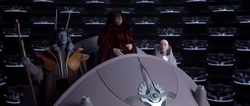
Sheev Palpatine was the first ruler of the Galactic Empire.
Amongst high-ranking military personnel, Emperor Palpatine's name was spoken with fear along with that of his Sith apprentice, Darth Vader, frequently styled as a "Lord" and treated with a similar fearful deference as Palpatine. Many considered Vader the Emperor's right-hand man—a living weapon—and viewed him as the natural successor to the Emperor's legacy.[9][74] In reality, the Emperor planned to live forever by uncovering the secrets to immortality via dark-side research into Sith alchemy,[7] as epitomized by Project Blackwing.[108] Ergo, the Empire lacked a clear chain of succession following both the Emperor and Vader's deaths.[7]
Following both the Emperor and Darth Vader's death, Imperial head of government and Grand Vizier Mas Amedda attempted to keep the Empire together, while new pretenders to the Imperial throne announced their ascension to power on a near daily basis.[7] Owing to a lack of communication, Imperial messages surrounding Palpatine's death were contradictory. Some such as Grand Moff Lozen Tolruck of Imperial territory G5-623 suggested that the Emperor had escaped the Death Star II through miraculous means. Others claimed the even wilder notion that the Emperor was still leading the Empire from beyond the grave.[10] Some simply refused to acknowledge the Emperor's death for months.[6][10] In order to counter the reports of the Emperor's demise, a proxy actor was installed in his place. Eventually, the truth of the Emperor's fate became known to the general citizenry. Declarations of a new Emperor were announced almost every day, but none were able to consolidate any substantial power. Splinter fleets and other Imperial officials fought each other to support the various claimants to the throne.[18]
Grand Admiral Rae Sloane became the public figurehead of the Galactic Empire after Palpatine's death.
In the months following the Battle of Endor, Grand Admiral Rae Sloane became publicly recognized as the de facto head of the Galactic Empire and Imperial Navy. In reality, power was held by Fleet Admiral Gallius Rax and his Shadow Council.[10]
On Coruscant, Amedda, the de jure ruler of the Empire and proxy Emperor, was held under house arrest by Gallius Rax. Mon Mothma refused to accept his surrender unless he could find a way to surrender the entire Empire.[10]
During the covert Imperial-backed Liberation Day terror attack on Chandrila, Sloane's aide Adea Rite executed a failed assassination attempt on the Grand Admiral per secret orders of Rax after Sloane refused to join his forces. Rax publicly claimed shock at the assumed death of Sloane. Instead of taking the mantle of Emperor, Rax chose the title Counselor to the Empire, vowing to act as an interstitial leader until the Grand Admiral's return. He was ultimately killed during the Battle of Jakku.[10]
Executive
- "Must I attend to every trivial matter, Vizier?"
"I apologize, my lord. But I believe you will want to attend to this one." - ―Emperor Palpatine and Vizier Amedda
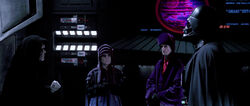
Advisors Aloo and Greejatus meet with the Emperor Palpatine and Lord Vader aboard the second Death Star.
While Emperor Palpatine held sole and supreme power within the Empire, he typically eschewed the day-to-day affairs of his government in favor of conducting extensive research into the dark side of the Force. As such, the mundane decision-making of the Empire's executive branch was conducted by the Imperial Ruling Council. The council was led by Grand Vizier Mas Amedda and the Emperor's closest advisors: Sate Pestage, Janus Greejatus, Ars Dangor, Kren Blista-Vanee and Prelate Verge. These individuals constituted the uppermost tier of the Imperial hegemony and wielded considerable powers over officers within the military. Moffs, generals and admirals all were answerable to the Imperial cadre, but even the councilors were not always privy to the doings of Imperial Intelligence. After the Emperor largely retired from public life, Vizier Amedda and the rest of the Ruling Council took to dispatching processions of Imperial skylimos to maintain an illusion that the Emperor still moved about in public.[7]
Darth Vader, the Emperor's apprentice and second in command, appeared in most cases to operate outside of the official Imperial command structure, and was noted by Moff Tarkin on one occasion to hold "an invisible rank." This apparently unstated authority was such that even Grand Vizier Amedda dared not issue him orders, and shared confidences with the Sith Lord when asked. He was also apparently granted nearly carte blanche to execute those who displeased him, even when those executions upset other members of the executive branch or were high-ranking military officials themselves.[9][7] However, rather like the Emperor himself and despite his authority, Vader had little involvement with the executive function of the Imperial government. Instead, he tended to involve himself in military affairs, and was often personally given assignments from Palpatine. Like Palpatine, Vader considered the Empire to be a mere tool for the two Sith Lords to use in their quest for greater power in, and understanding of, the dark side.[7]

Amedda served as head of the Ruling Council and as an intermediary for the Emperor.
With the Ruling Council's inability to successfully run the Empire following death of Emperor Palpatine in 4 ABY, Fleet Admiral Gallius Rax proposed a new executive branch called the Shadow Council that would be a more covert and militaristic body than the Ruling Council it sought to replace. The Shadow Council would consist of various advisors, Admirals and Generals with Grand Admiral Rae Sloane as the group's de facto leader until her supposed "disappearance."[10][109]
Legislative
- "The Imperial Senate is only a shadow of what it was in the days of the Republic, but someday, I hope, it will be remembered as the cradle of an alliance that brought freedom back to the galaxy."
- ―Senator Bail Organa, to Princess Leia Organa

The Imperial Senate served as the New Order legislative organ until it was disbanded.
The Imperial Senate was reduced to the lower tier of government and gradually lost the prestige it once held as the forum for galactic debate, as increasing numbers of senators became entangled in Emperor Sheev Palpatine's web of corruption, which began earlier during the Clone Wars.[106] With the once-powerful Senate firmly in Palpatine's hands, passing legislation became a mere formality for the New Order, while Senators and galactic citizens were made to believe that they had a voice in galactic politics.
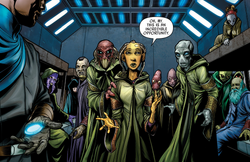
Senators held little real power under the Emperor's watch.
In reality, Palpatine held unlimited executive power and was the only one who could formally pass legislation. While most feared to speak out against the Emperor, a few such as Bail and Leia Organa of Alderaan actively questioned the accountability of the Empire and its actions, much to the ire of Imperial authorities. Suspicions eventually arose that Leia Organa was using her diplomatic immunity to help the Rebel Alliance. The Empire also lied to the Senate about the destruction of Jedha City, claiming that it was a mining accident.[73] The Emperor used Leia's capture aboard the Tantive IV, which was known to be carrying technical readouts for the Death Star, as an excuse for disbanding the Imperial Senate shortly before the Battle of Yavin.[1] With the dissolution of the Senate, the last remnants of the Old Republic had been swept away, and the legislative authority over the various systems and sectors passed directly to the regional governors—effectively transitioning governance into military jurisdiction, who answered directly to the Emperor.[1]
Territorial
- "I am an extension of the Emperor's will. My actions here simply execute his directives. The Emperor is the mind. I am his tool."
- ―Governor Ssaria of the Castell system

Randd was Grand Moff of the Exterior sector in the Outer Rim Territories.
Galactic territories from the Core Worlds to the Outer Rim Territories were overseen by regional sector governors, or Moffs, who as part of the Imperial Military wielded much of the power over each sector[58] and who enforced the Galactic Emperor's rule across each sector.[110] This stemmed from the Sector Governance Decree that Palpatine passed during the later stages of the Clone Wars, when he was Supreme Chancellor of the Galactic Republic.[111] With only twenty Moffs at one time, they were answerable to the Ruling Council, and all positions were dominated by humans. But they themselves were outranked by the position of Grand Moff, established in 14 BBY and first granted to Moff Wilhuff Tarkin, who were governors of oversectors, areas of space that contained several planetary sectors and were used to keep the Moffs or sector governors in control.[7] After the Imperial Senate was disbanded, all legislative power went to regional governors at the beginning of the Galactic Civil War.[1] The local governing bodies such as the Monarch of the Royal House of Naboo were downgraded to a mostly ceremonial and powerless role,[112] as were the senators they sent to the Senate, who all served under a Moff's oversight.[38]
After Emperor Sheev Palpatine's death during the Battle of Endor, Imperial territories fell into total unrest, with some military leaders such as Valco Pandion appointing themselves Grand Moffs, while corrupt sector governors began accepting payments for the New Republic's allocation of Imperial ships or suing for peace.[12] Other governors, such as Grand Moff Lozen Tolruck of Imperial territory G5-623 and Governor of the Anoat sector Adelhard, broke off from the Empire, forming Imperial remnants.[10][32]
Planetary
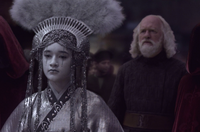
The planetary Queen of Naboo Apailana with Sio Bibble during the start of the Imperial Era
Many planetary governing bodies were allowed to exist under the Empire, such as the Royal House of Naboo, House of Organa and the royal family of Kessel. They were allowed to retain their system of government with their ruler pledging loyalty to the Imperial throne but having their role reduced to a mere ceremonial one such as the Monarch of Naboo. Most were able to retain a seat in the Imperial Senate as it had been in the Old Republic,[112][31] while planets such as Lothal, Mandalore[66] and Mon Cala[113] were placed under direct military rule.[14] Some planets, like Ryloth and Jedha were classified as free and independent protectorates, but were actually under de-facto occupation. While Ryloth had a seat in the Senate, many viewed its Senator as nothing more than a puppet of the Empire.[38][114]
Examples of indirect rule in the form of protectorates and vassal states include the Satrapy of Myrra of Akiva, or the Kingdom of Shu-Torun, which imposed Imperial laws, taxes and demands on their populations..[12][115]
Organization
- "Efficiency is predictability. The Empire is nothing if not efficient."
- ―Everi Chalis
Administration and bureaucracy
- "The war is over. The Separatists have been defeated, and the Jedi rebellion has been foiled. We stand on the threshold of a new beginning."
- ―Emperor Sheev Palpatine
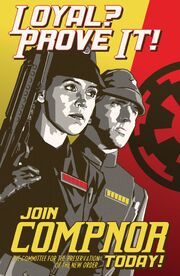
COMPNOR recruitment poster COMPNOR Recruitment by Dasita Lyros
While the Emperor maintained a galactic armada and commanded the undisputed military, scientific, and economic hegemony in the entire galaxy, the ever-present fear of surviving Jedi haunted Palpatine throughout his reign. In direct response to this feared threat, the Empire employed numerous Dark Side Adepts, Force-sensitive individuals of the Inquisitorius trained to track down and eliminate any surviving Jedi. Due to the nature of their mission, Inquisitors could commandeer local Imperial forces and possessed authority over other officers in the Imperial Military.[31][116]
While dark-side leanings and occult goals may have fascinated the Empire's ruler, the banal commonalities of ruling a galaxy-wide Empire never failed to impress upon the Imperial leadership. With the rise of the New Order, many previous governmental agencies were re-named and re-purposed, while many official buildings saw themselves remodeled to fit a darker and more angular aesthetic. One such agency was the Republic-era COMPOR, newly dubbed COMPNOR, the Commission for the Preservation of the New Order.[7] COMPNOR served as the Empire's chief umbrella agency dedicated to ensuring order and stability for the countless worlds under the Emperor's rule while supporting the new regime through both propaganda and intelligence services. Organizations such as the Imperial Security Bureau, Imperial Intelligence, and Ubiqtorate worked under its oversight, with the ISB helping to stamp out potential dissident actions along with Imperial Intelligence's vast information and data gathering operations on the countless citizens in the galaxy.[34] Also working under the auspices of COMPNOR was the Ministry of Information, designated under the Coalition for Progress. The Ministry was primarily tasked with muzzling the HoloNet News Agency of anti-Imperial messaging and ensuring the necessary infrastructure for the vast communications systems within the Empire. It also worked to monitor the Imperial Press Corps at the grand COMPNOR arcology, located in the Federal District of Coruscant, Level 5127.[7][117]
The Empire also maintained the Imperial Information Office, which employed civilians to help the Empire and its massive data operations in the galaxy, allowing employees the option to cybernetically enhance their performance with AJ^6 cyborg constructs.[14] The Ministry of Agriculture and Imperial Agricultural Collective oversaw the horticultural aspect of Imperial dominion, with officials on many worlds across the galaxy, including Lothal.[118] The Economics Ministry, Education Ministry, Weather Ministry, Transportation Ministry and Imperial Survey Corps also employed numerous citizens across the Empire.[119][90]
Following the Battle of Endor, COMPNOR would be reorganized into the Office of Imperial Promotion, Galactic Truth, and Fact Correction.[10]
The New Order
- "They got propaganda all over. Lovely lawful Milvayne! Proof how perfect a world can be when you let the Emperor in!"
- ―Vulaada Klam, on Milvayne
COMPNOR-approved propaganda poster by Resinu Santhe-Caltra
The New Order referred to the political religion of the Empire and the values of which it stood by. Numerous organizations were folded under COMPNOR, the Commission for the Preservation of the New Order. These included the Imperial Security Bureau, Coalition for Progress, Imperial Intelligence, and CompForce, along with science divisions and youth education initiatives.[11][45][29][78]
The Galactic Empire wielded a vast and powerfully effective propaganda machine to shift the opinions and cultures of numerous worlds across the galaxy. Celebrating the end of the destructive Clone Wars and the creation of the New Order, the Emperor founded Empire Day as the national holiday of the Empire. The song "Glory of the Empire" served as the national anthem.[14] Due to physical alterations to Palpatine to make him look younger and more appealing in broadcasts, many citizens did not know of the Emperor's scarred appearance,[14] nor did they comprehend that the galaxy was under the command of a Sith Lord.[120]

A propaganda poster featuring the Grand Inquisitor, leader of the Inquisitorius
To enhance its legitimacy in the eyes of the people, the Empire used the duel in Palpatine's office to officially support the idea of a "Jedi Rebellion" occurring, and that the Jedi Order had attempted to stage a coup intent on taking control of the Republic, thus necessitating Order 66. In the years after the Proclamation of the New Order, all remaining recordings of the Jedi were removed, with many eventually believing and supporting the Emperor's version of events. However, individuals such as Zaluna Myder and even Luke Skywalker questioned the Empire's account of the events leading up to their destruction, while those who knew the Jedi in person could not bring themselves to believe in a Jedi-led coup.[35][78] Those who attempted to distribute independent publications could be punished with imprisonment without term.[18]
Nonetheless, with the end of the Clone Wars and the dismantling of the Separatist Droid Army, a renewed sense of peace and prosperity returned to the Core.[7] This peace was aided by the efforts of the Coalition for Progress division of COMPNOR, who took note when artistic media appeared to undermine the Empire, using its authority in one instance to dismantle a statue of Janyor of Bith on the Outer Rim world of Garel,[45] or by banning subversive operas such as the Song of Lojuun[29] and sending members of the band Hakko Drazlip and the Tootle Froots to work in the mines of Kessel after a song with political undertones mocked Lord Vader, with the song being declared contraband as a result.[78]
Foreign relations
The Galactic Empire, while seeking domination over the galaxy, nevertheless maintained a number of foreign relations with several independent and client entities during its political existence. It also established a number of protectorates across the galaxy.[38]
An alliance was brokered with Fenn Rau's Mandalorian Protectors, an ancient group of Mandalorians residing in the independent Concord Dawn system, which was tasked with dealing with potential rebels by reporting on their activities, and destroying them if possible.[101] However, sometime after the rebels imprisoned Rau, the Protectors' secret alliance with the rebellion was discovered, and the Imperial Viceroy of Mandalore, Gar Saxon, wiped out the Protectors in 2 BBY.[42]
The Empire maintained good relations with the Mining Guild, a network of miners who harvested natural resources and operated in full association with the Empire and was granted the rights to use a special variant of the Imperial TIE fighter.[121][122]
In 0 ABY, following the destruction of the Death Star during the Battle of Yavin, and the loss of Weapons Factory Alpha during a rebel assault on Cymoon 1 during the Galactic Civil War, Lord Vader, on behalf of Emperor Palpatine, traveled to Tatooine as an ambassador to negotiate a deal with the Hutt Clan to secure raw materials for production and resources to fuel its military operations. Jabba the Hutt accepted this, bringing the Clan into the galactic conflict.[39]
Law enforcement
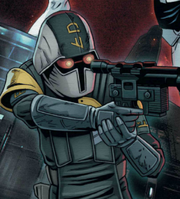
A Coruscant Security Force police officer during the Imperial Era
Law enforcement in the Empire was primarily the responsibility of local planetary security forces,[75][94] however, as time wore on, these local forces were gradually phased out in favor of the Military Police of the Imperial Army and Navy.[11] The Military could also enforce civilian law regardless of whether the world was under occupation. For instance, the Purge Troopers enforced Imperial rule in the Anoat sector on behalf of Governor Urik Adelhard during the Iron Blockade.[32]
Private contracts were occasionally given to the Bounty Hunters' Guild and freelance bounty hunters to track down elusive elements within Imperial dominion,[39] although this practice was largely frowned upon.[10] In order to support law enforcement communications, the Empire maintained the Imperial Office of Criminal Investigations. The Office was responsible for the Imperial Enforcement DataCore, which could only be accessed by authorized Imperial personnel or licensed bounty hunters.[123][30]
Mining stations, deep-space outposts, or jails far from the cosmopolitan core often used Imperial Navy Troopers as security personnel, who, while still imposing, commanded less respect than their stormtrooper brethren.[29] Vast trading posts, such as the Ring of Kafrene in the Thand sector, used mainly stormtroopers to enforce law and order on its streets.[73]
In the justice system, a defense was only allowed in civil cases, not trials against the Empire.[18] The Ministry of Ingress on Coruscant was the organization responsible for processing immigrants arriving on capital.[124]
Military
- "Look on our new military not as trespassers or interlopers, but as gatekeepers, here to shore up the Emperor's vision of a pacified and prosperous galaxy."
- ―Wilhuff Tarkin
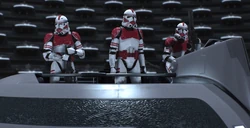
Clone troopers served as part of the Imperial Military before being phased out.
As the direct successor to the Republic military, the Imperial Military comprised vast numbers of warships and countless soldiers. One of the most recognizable warships being the Imperial-class Star Destroyer, the mere sight of one usually being enough to bring a troublesome system in line. Rule through fear of force rather than force itself was the driving philosophy throughout the Imperial Military, epitomized by the Tarkin Doctrine. Bolstered by the near limitless resources at the Empire's disposal and loyalist companies such as Taim & Bak, Borstel and Phylon, corporations such as Kuat Drive Yards and its subsidiary Kuat Systems Engineering produced many of the New Order's Star Destroyers, as well as the formidable All Terrain Armored Transport, which was frequently deployed at hot spots throughout the galaxy.[9][31] The AT-AT became to be feared for its formidable chin-mounted heavy laser cannons, while lighter walkers such as the All Terrain Defense Pod featured a single laser cannon able to be rotated independent of the walkers front-facing direction, and were deployed primarily to protect Imperial Military interests on backwater worlds. BlasTech Industries was the primary weapons producer for the widely used E-11 blaster rifle.[31] The Aratech Repulsor Company manufactured the 614-AvA speeder bike, commonly referred to as the Imperial speeder bike, which would eventually be replaced by the 74-Z.[125] Sienar Fleet Systems produced many of the Empire's Imperial TIE fighters and variants, such as the TIE Advanced v1, which was originally unveiled on Empire Day and featured dual chin-mounted laser cannons and the ability to launch warheads such as the XX-23 S-thread tracker.[14] The TIE Advanced x1 naturally became the next evolution of the deadly v1, as well as the preferred craft of Lord Vader. In addition, the Empire inherited the military assets of the defunct Separatist movement—the most notable of which was the Death Star.[3]
A typical Imperial Military recruitment poster
Leading the Imperial Military were highly trained admirals, generals and Moffs who were instructed at the numerous Imperial Academy complexes throughout the galaxy. Several veteran officers also formerly served in the Galactic Republic, with decorated members such as Wullf Yularen. During the sixth year of the Emperor's reign, twenty Moffs answered directly to the Imperial Ruling Council. The title of Grand Moff was specifically created for Wilhuff Tarkin, while other Moffs such as Tiaan Jerjerrod and Therbon sought to increase their reputation with the Emperor.[74] Some ambitious officers even supported insurgent activities with later plans to betray and destroy them in hopes of a promotion. It was not uncommon for high-ranking officials to maintain private investments, with Hiram Zataire owning large plantations and a vineyard on Naboo, and Cassio Tagge being a member of the Tagge family, which held ownership of TaggeCo and its mining facility at Lucazec.[126][7]
The Imperial Army and Navy were responsible for carrying out the Empire's military operations across the galaxy. Ostensibly dedicated to maintaining law and order,[3] Imperial Military forces came to be feared and fled from.[1][9][74] Perhaps the most ubiquitously visible element were the Imperial stormtroopers. These faceless soldiers were the enforcers of Imperial order, often exercising a "shoot-first" policy.[1][9][74] Following the Battle of Endor, the Galactic Empire's martial forces began to suffer both resource and personnel shortages, ultimately forcing untrained and untested recruits to fill the front lines in the Imperial war effort, while the once-mighty Imperial Navy of thirteen Super Star Destroyers was reduced to one, the Ravager, which was ultimately destroyed during the Battle of Jakku.[12] After the end of the Galactic Civil War with the signing of the Galactic Concordance, the mobilization and training of stormtroopers was prohibited.[13]
Tarkin noted an "institutionalized suspicion" within the Imperial Military, which he believed was used as a tool by Emperor Palpatine to control the various members of the Empire and its numerous organizations. There also existed an intense fear of the Emperor and Lord Vader, mainly due to harsh punishments, such as death or torture, if a task was not completed in time or resulted in failure. Imperial patrol transports and stormtroopers were often utilized as the local police force for numerous worlds, while off-duty personnel could frequent local venues and neighborhoods after signing out of their local garrison. The euphemism "off-base, recreation," was used in the Imperial Military when referring to the visiting of various mistresses or cantinas by personnel, while out of consideration it was common for duty officers to ask no questions about such escapades.[38] Members within the Imperial Army believed that those stationed farthest from the Imperial Center were deemed less important to the New Order, causing many to resent deployments on remote worlds such as Belderone.[7]
Bio-warfare and genocide
- "The only thing I know about Geonosis is that the population is gone. I never asked questions."
"Well, maybe you should start. Or are you afraid of the answers you'll get? Afraid you'll learn the Geonosians were wiped out by your precious Empire?"
"And why would we do that? What could possibly be the point?"
"Ah, good questions. Chase the answers, and maybe you'll learn the truth." - ―ISB Agent Alexsandr Kallus and Garazeb Orrelios
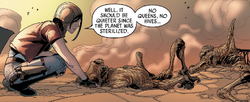
The result of the Sterilization of Geonosis
The nascent Empire conducted numerous atrocities, often resulting in genocide owing to the Empire's humanocentric tendencies. On Geonosis, the Empire sterilized the planet's native Geonosian population with heavy bombing.[35][127] The Lasat homeworld of Lasan was ecologically destroyed by the later banned T-7 ion disruptor rifles,[128] and the entire species was almost wiped out. Furthermore, to make advances in bio-warfare, Vice Admiral Perwin Gedde tested ancient diseases on captive worlds, raining sickness from sub-orbital battleships.[10]
A vast distribution network existed within the Empire, with numerous warehouses on various worlds holding thousands of biological agents. Biological testing was conducted on planets such as Coyerti or against primitive indigenous populations and Wookiee slaves.[29] While most research and development went unhindered, a few initiatives went out of control. On Dandoran, the accidental release of a highly contagious virus under the code name Project Blackwing—a clandestine effort seeking to uncover the secrets to immortality—ultimately led to an outbreak across the planet.[129]
Economy
- "—we mustn't forget that we have the credits. The credits to spend how we see fit."
- ―Arsin Crassus, financier, who thought that money was the solution to the Empire's problems
The Galactic Empire adopted a planned economy, whereby production and distribution of goods were centralized and directed in the immediate aftermath of the Clone Wars.[7] This policy of nationalization was called imperialization.[4] Despite this, numerous third-party corporations were allowed to remain, with major loyalist companies Kuat Drive Yards and Sienar Fleet Systems producing the majority of the Empire's land and space-based craft. Companies aligned with the Confederacy of Independent Systems during the Clone Wars, such as the Techno Union and Trade Federation, were absorbed by the newly formed Empire, and all Federation accounts plundered by Imperial financier Arsin Crassus.[32][12] By 0 BBY, both Incom Corporation and the Corellian Engineering Corporation had been nationalized.[4]
In addition to the Imperial Mining Institute, the Empire held a close association with Mining Guild.[122][121]
Towards the end of the Galactic Civil War, Fleet Admiral Gallius Rax began to nationalize all aspects of the Imperial production chain in the months following Endor, but the attempt proved unable to save the dying Empire. The continued funding of the Imperial Military was hotly disputed. While briefly considered, it was decided that plundering the InterGalactic Banking Clan and other monetary bodies would plunge the galaxy into an economic depression.[10]
In 19 BBY, the Republic credit was replaced by the Imperial credit, which became the standard currency in circulation throughout the Empire. With the advent of the New Order, credits from the time of the Galactic Republic became worthless as they were phased out.[130] Since the Imperial credit was a fiat currency, credits from the Empire gradually lost their value following the formation of the New Republic.[10]
Slavery
- "We have a surplus of slave labor—but what to do with it? Could the Wookiees be farmed for their meat? Presently it's stringy and tough, but maybe if they could be fattened up, or modified in some way—crossbred with another species, perhaps, like the Talz."
- ―Commandant Theodane Sardo
The Empire's rise saw the gradual repeal of Republic anti-slavery laws.[44] Species such as the Wookiees were declared non-sentient. Subsequently much of the Imperial war machine was built on the shoulders of the enslaved Wookiee population, who saw their homeworld of Kashyyyk ecologically devastated.[10]
Within the Empire, non-humans were routinely subjugated, with many sent to numerous slave labor camps across the galaxy, one of the most infamous being the spice mines of Kessel, where Wookiee slaves, prized for their strength, were sent to mine the valuable spice located in the planet's interior. It was a literal death sentence for many, with an expected survival time of three months.[31] Humanoid species often had a longer survival time, ranging from one to two years in the mines.[78]
Abusive and exploitative, the Empire forcibly relocated settlers and pressed them into Imperial factory work. Resisting could see ones family be kidnapped and killed.[131] Unemployment in strategic resource systems was declared unlawful.[35] On Ryloth, isolated settlements often existed with little or no knowledge about the Empire at large, with those same camps oftentimes being disbanded and their inhabitants relocated to slave labor camps when needed. Escaped slaves or displaced persons often made up these camps, similar to Tarkintown on Lothal.[38] Those that resisted Imperial rule could see their whole planet devastated and species reduced to near-extinction, such as the reptilian Bodach'i, who were forced to work in spice mines on planets such as Kerev Doi.[18]
Transport
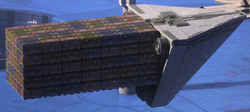
An Imperial cargo ship docked at a space port
A vast transportation network to connect Palpatine's vast Empire served as the primary means of both civilian and military transport. Interstellar commerce and warfare primarily occurred along one of several major hyperspace lanes—considered trans-galactic highways—with their knowledge and existence dating back to well before the former Galactic Republic. With the major trade routes considered safe for hyperspace travel, their control was vital for maintaining an effective means of defense and galactic dominance. In smaller systems, hyperspace beacons could transmit their coordinates, allowing starships to make quick jumps to and from the system. As a result, destroying them could hinder enemy mobility and response times. Serving this vast system were spaceports, facilities where starships would dock and refuel, restock and rearm. Spaceships serving as fuel stations also existed in the vastness of the galaxy, along with major shipping ports such as Horizon Base.[116][7] Owing to the immense size of the Empire, a vast, complex logistical network was maintained by the Imperial hierarchy, and as a result was both immensely interconnected and extremely fragile. Locales such as Mardona III served as "warehouse worlds": planets turned storehouses for millions of metric tons of goods to fuel the Empire. Imperial cargo ships often transported these resources across the galaxy; slovenly and low-quality personnel, or fresh recruits just out of the Academy, often crewed these vessels, owing to their rather menial task.[132]
Communications and media
- "Citizen reporting has been a key tool in maintaining peace and order across the Empire."
- ―Alton Kastle
COMPNOR-approved propaganda poster by Resinu Santhe-Caltra
Acquiring much of the galactic communications systems from the former Galactic Republic, the Empire nationalized the HoloNet News and its galaxy-spanning broadcasts and hyperspace-powered communication systems. The new Imperial Holovision was overseen by the Ministry of Information, who in tandem with the Imperial Press Corps, ensured reporting stayed in line with "acceptable" news coverage and government policy.[101][133][134] While the Imperial holoNet was the only state-sanctioned news agency, local news outlets that supported the Galactic Empire were allowed to remain.[135] Those that attempted to distribute independent publications could be imprisoned without term.[18] It was also law that the Imperial HoloNet be broadcast at all times in every drinking establishment.[14]
As expected, the galactic HoloNet remained one of the most-viewed news stations in the galaxy, forming public opinion and reporting on pro-Imperial issues and events. When military objectives trumped civilian information, the Empire shut down the local HoloNet in varying sectors, and prioritized HoloNet transmissions to the military, giving Palpatine and his armed forces near-instantaneous communication across the entire galaxy.[14][7] Following the Battle of Endor, the New Republic abolished the Empire's restrictions and censorship on HoloNet and encouraged the creation of several HoloNet channels including the Queen of the Core Network to win over the galactic public after it assumed control by 5 ABY.[12]
Science and technology
- "The universe is old. We are running out of time. I desire progress..."
- ―Doctor Cylo-V
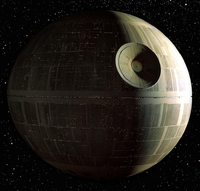
The Death Star was one of the Empire's greatest engineering projects.
One of the Empire's most ambitious scientific developments was the Death Star, a moon-sized, deep-space mobile battle station designed to fire a single planet-destroying superlaser powered by massive kyber crystals and built in orbit of Geonosis. Started by the Galactic Republic during the Clone Wars and continued under the leadership of Krennic, who oversaw the Advanced Weapons Research, which was responsible for the completion of the long-delayed project, this was supported by a complex logistical network of bases.[4]
The Empire was also believed to have created many other superweapons, such as the Onager-class Star Destroyer, a type of capital ship that utilized a kyber-crystal superweapon; the Mass Shadow Generator, which was rumored to exist in realspace and hyperspace; the Torpedo Sphere, a siege platform and space station; the Omega Frost, an interstellar freeze ray; and the Electro-Proton Bomb/Defoliator, which was based on the Republic's electro-proton bomb from the Clone Wars.[111] The Dark trooper program, deemed a failure, led to the Empire's disillusionment with battle droids.[11]
Experimental starships including the TIE/IN interceptor and TIE/D Defender pushed the Empire's technical capabilities, and introduced concepts and technology that would be reincorporated in future ship designs throughout the New Republic Era.[136]
A group of Sith scientists used alchemy and science to develop Project Blackwing, to achieve immortality, with the project being based out of a secret research facility on Dandoran. However, the project went awry when a virus known as "the Sickness" was accidentally created and killed its hosts, turning their bodies into intelligent cannibalistic zombies known as Undead Troopers.[137] Imperial scientists working on Project Celestial Power also tried to contain dark-matter quintessence.[111]
The Emperor himself had planned to further push the boundaries of what could be accomplished without the Force, creating cybernetically enhanced supersoldiers under the development of Doctor Cylo at his heavily guarded research base. Owing to Vader's failure to protect both the first Death Star and Weapons Factory Alpha, Palpatine planned to eventually form an army of cybernetic soldiers as his primary enforcers, reducing Vader's position as apprentice to a mere ceremonial role.[138]
The Imperial Mining Institute also existed under the New Order, while the Imperial Department of Military Research helped boost the combat forces of the Empire, developing the widely used stormtrooper armor and the IT-O Interrogation Unit, along with the 9D9-s54 Dianoga spy droid.[31][139] The Empire also initiated Project Harvester, a clandestine operation designed to root out children with Force sensitivity and detain them at an underground facility connected to the Arkanis Academy, located on the Outer Rim world of Arkanis.[140]
Demographics
As a pan-galactic Empire, the Empire was home to countless alien species across the galaxy. In terms of preference, the population of the Empire was dominated largely by humans, a species native to the Imperial capital world Coruscant.[32] Humans were the most common species in both the Imperial Military and the Empire's political circles, with the highest echelons of the New Order almost entirely consisting of the species.[141]
To increase the human population and military manpower, several Imperial breeding programs were enacted in the early days of the Empire. They encouraged people to start and grow families, and rewarded them for it. While the Empire supported traditional heterosexual relationships, it did not care about the individual sexual preferences of its citizens, provided that such individuals kept their affairs behind closed doors, and did not interfere with any of its family programs.[10]
Language
As a human-dominated government, the Galactic Empire supported Galactic Basic and its Aurebesh/High Galactic writing system. Learning of foreign languages and cultures for the general populace was disapproved of.[12]
Religion
Officially, all organized religion and belief in the supernatural was outlawed.[142] In reality, the vast size and scope of the Empire meant that thousands of religions were practiced across its vast territory. The Seswenna sector alone had over three hundred distinct religions with active practitioners, all officially recognized by the local Imperial administrator. Chief of the Imperial Navy Conan Antonio Motti himself claimed to be a "man of faith," and believed that Imperial unity could only be strengthened through cooperative and constructive dialogue among citizens following diverse spiritual traditions.[143] Underground religions surrounding the extinct Jedi such as the Church of the Force and the Guardians of the Whills continued to exist despite their perilous closeness to the Jedi of old.[13][4]
Society and culture
- "Can you stop thinking of yourself as a native of your home planet and begin thinking of yourself as an Imperial first? An Imperial only? Can you accept that protecting and serving the world you came from is best accomplished by strengthening the Empire to which it belongs?"
- ―The introductory speech at the Royal Imperial Academy on Coruscant
Aesthetic
The transition from the Republic to the Empire was also marked by major changes in the new government's architectural aesthetic. While the democratic government favored sweeping lines in its architecture, Palpatine's authoritarian regime preferred bold and brutalist designs. This brutalist style first emerged before the foundation of the Empire during the Clone Wars, when the architect Orson Krennic transformed the municipal grounds on Coruscant into military command centers.[4] A prime example of Krennic's work was the Republic Center for Military Operations.[144]
Sports
Grav-ball was a popular sport within the Galactic Empire, with many worlds hosting teams that occasionally competed with one another.[118] Underground gladiatorial games existed within Imperial territories, the Outer Rim Carve-up and Stormblade Bloodfest being some of the organized occurrences of the sport within the early years of the Empire.[123]
Xenophobia
- "... I have no issues with aliens myself—some of my best friends are nonhumans—but some grav-ball fans object to alien physiognomies, seeing them as giving nonhumans an edge."
- ―Athletic Director Janus Fhurek
Humanocentric single-species domination was not coincidental, but intended. Imperial propaganda actively supported state-sponsored ethnocentric xenophobia and fear-mongering. To the Empire, "aliens" were by and large unwelcome within its order, with aliens being seen as "different" and "strange." As such, the Empire treated nonhuman segments of its populations as serfs, slaves, or obstacles needing to be tamed, removed, or ignored. The Empire supported the idea that aliens were untrustworthy—unlike humans—and behind their veneer of innocence lurked a vicious monster. The Imperial propaganda machine was so effective in its message that even near-human species exhibited an inherent distrust towards nonhuman populations.[10] Since the Empire looked down on aliens, it was rare for aliens to serve as Imperial officers.[31] Nevertheless, some nonhumans were known to occupy lofty roles within the Empire, such as the Chagrian Mas Amedda, who served as the Empire's Grand Vizier,[7] the Imperial Grand Admiral Thrawn,[58] and the Pau'an Grand Inquisitor, the leading figure in the Inquisitorius during the Age of the Empire.[37] In addition to state-sponsored discrimination against a predominantly nonhuman galaxy, the Empire discouraged the learning of alien languages and cultures such as Ithorese in an effort to destroy foreign cultures, and sought to impose high "Imperial standards" for its citizens.[12]
The destructive nature of the Clone Wars and use of droid armies by the Separatist Alliance fostered and expounded anti-droid bigotry so well into the galactic psyche that it would endure well into the Imperial Era.[6] The Empire saw droids as servants and tools, to be discarded and thrown away when no longer useful.[10]
Astrography
Administrative divisions
- "Was it not you who suggested the creation of oversectors and oversector governance as a means of enhancing our control?"
- ―Emperor Palpatine, to Wilhuff Tarkin
While the Empire utilized the senators of the Imperial Senate to maintain control of their respective systems, control was gradually given over to Imperial sector and planetary governors, or Moffs. Grand Moffs were charged with overseeing control of oversectors, which comprised numerous sectors,[7] and the Imperial Navy was organized into sector fleets.[54] Rather than direct annexation, many of the Empire's territories were controlled through puppet states, alliances, and protectorates, most notably the Corporate Sector.[29]
On the border of the Mid Rim and Outer Rim Territories, an invisible boundary was considered the "front line" against the lawlessness of the Outer Rim.[29] The Imperial sphere of influence ended shortly before reaching Hutt Space, resulting in its reputation as a haven for smugglers, bounty hunters and other denizens of the galaxy.[76]
The Empire also maintained strategic resource systems, in which industrial surveillance, heightened security measures and higher work quotas were in effect, and were often placed under the supervision of influential barons, moguls and efficiency experts.[35]
Early expansionism
As the successor state to the Galactic Republic, the Galactic Empire's authority spanned most of the known galaxy. Its reach was vast, claiming as its own every territory within the former Galactic Republic, as well as those which had joined the Confederacy of Independent Systems.[3]
The Core Worlds housed some of the richest and most affluent planets in the Empire, with gradual economic decline and lawlessness appearing the further one ventured from the Core. While the Emperor planned to claim the Outer Rim, the logistical complexities of such a feat soon became apparent. Many of the exoplanets were too rough, wild, or strange to ever be brought under Imperial yoke. Thus, many were relegated to hold meager garrisons or host temporary military excursions. As a result, exploitation, weapons testing and military installations dotted the Outer Systems, while Imperials often came for the drinking, smoking, gambling, or black-market goods.[12]
Seeking the source of the Dark Side, the Empire established numerous labs and communications stations on distant moons and asteroids beyond known space, with Emperor Palpatine believing his power was drawn from beyond the galaxy.[12] The Imperial Survey Corps helped Palpatine chart the unexplored regions of the galaxy.[145] Palpatine maintained relations with the Chiss Ascendancy, a regional power located within the Unknown Regions through its ambassador, Mitth'raw'nuruodo, better known as Thrawn. Palpatine accepted Thrawn as his adviser on matters involving the Unknown Regions, and hoped they would both fight potential future threats from the Unknown Regions.[44]
Retreat and collapse
- "The factories of Kuat have been bombed into submission, and the shipyards of Xa Fel, Anadeen, and Turco Prime are all either contested or already lost. But the Outer Rim will be our savior—and it will be the strangling cord we tie around the neck of the New Republic. We already have three worlds under our sway there: Zhadalene, Korrus, and Belladoon."
- ―Gallius Rax, to the Shadow Council
Following the Battle of Endor, the Galactic Empire steadily began to shrink, losing numerous worlds to the recently formed New Republic, with Imperial assets and academies on worlds such as Uyter destroyed in bloody warfare.[12] With the loss and failure of three successive sieges to retake the Mid Rim world of Naboo, birthplace of Palpatine and thus an influential rallying point for the Empire's shattered forces, the Empire retreated to numerous fallback positions on strategically unimportant worlds such as Naalol, often drawing the New Republic into long and indecisive conflicts, forestalling its slow push toward the Core Worlds. Despite these efforts, the Republic had already established its capital on Chandrila, a planet located within the Core.[12]
A few months after Endor, the Imperial Future Council met on Akiva, a planet in a sector of the Outer Rim still under Imperial control.[12] Roughly two months after the Battle on Akiva, the Galactic Empire's territorial possessions were rapidly shrinking and described as a "patchwork quilt" by Grand Admiral Rae Sloane. Numerous systems left the Empire or waged their own resistance movements, declared their independence, and established their own fiefdoms or joined the New Republic. Criminal syndicates flourished in this atmosphere of conflict, especially the reptilian pirate Eleodie Maracavanya, who had captured the Super Star Destroyer Annihilator and used it to forge her own criminal empire. Various moffs and governors rebelled against the Empire, while more and more people asked what exactly the Empire was. Agencies, personnel, and whole planetary systems started to drift apart, each adopting differing tactics and methods for combating the New Republic, and each other.[10]
By this time, the Empire had already lost numerous systems to the New Republic's lighting-fast strikes, and factionalism had begun to scar any attempts to reclaim lost territories. The New Republic had already made headway into the Core Worlds. The last sector of the Outer Rim under Imperial control was a thin region of space known as the Exterior, along with the planets Zhadalene, Korrus, and Belladoon. With the shipyards of Kuat, Xa Fel, Anadeen, and Turco Prime having already been lost or contested, Rax planned to use the Empire's last foothold in the Outer Rim as a "strangling cord" to tie around the New Republic.[10] While the Chandrila terror attack demoralized the New Republic, it failed to turn the tide of the war against the Empire, which soon after lost Kashyyyk following an uprising led by Han Solo and Chewbacca.[10]
After their defeat at Jakku and the signing of the Galactic Concordance, some Imperial warships began jumping into the Unknown Regions to escape the prying eyes of the New Republic. This was made easier since parts of the Unknown Regions had previously been explored by military scout ships surveying star systems and blazing hyperspace routes known only to a select few.[142]
Behind the scenes
The Galactic Empire first appeared as the main antagonist of the first Star Wars movie, Star Wars: Episode IV A New Hope, in 1977. It later appeared in the two other films of the original trilogy: Star Wars: Episode V The Empire Strikes Back and Star Wars: Episode VI Return of the Jedi. George Lucas later used the prequel trilogy to chronicle the events which led to the rise of the Empire.
The Empire's origins and role in the Star Wars universe were subsequently expanded by various Expanded Universe literature and media over the next four decades. Following the Lucasfilm Story Group's decision in May 2014 to reboot the Star Wars universe,[146] the Galactic Empire reappeared as a major antagonist in new canonical media and literature, including the Disney XD television series Star Wars Rebels.
According to the author Jason Fry, the Galactic Empire in the newly established canonical universe was not openly xenophobic and misogynistic, unlike the Legends version. However, he acknowledged that some of the Empire's most devoted supporters were xenophobes, like his character Janus Fhurek, a minor antagonist in his 2014 junior novel Servants of the Empire: Edge of the Galaxy. In his view, the presence of prominent Imperial female characters in John Jackson Miller's novel A New Dawn and Star Wars Rebels precluded the idea of a misogynistic Empire.[147] Pro-human xenophobia within the Imperial Military and government bureaucracy has since been confirmed in the reference guides Star Wars Rebels: The Visual Guide and Star Wars Rebels: Visual Guide: Epic Battles, and the novels Aftermath: Life Debt and, particularly, Thrawn.
Financial engineering professor Zachary Feinstein calculated that the hypothetical GDP of the Galactic Empire would be 4.6 sextillion per year.Cite error: Invalid <ref> tag; invalid names, e.g. too many


